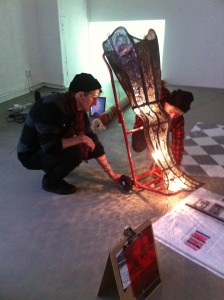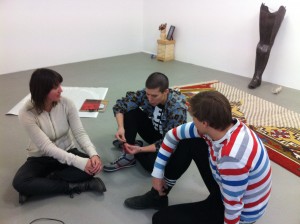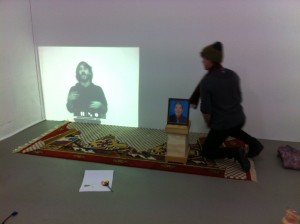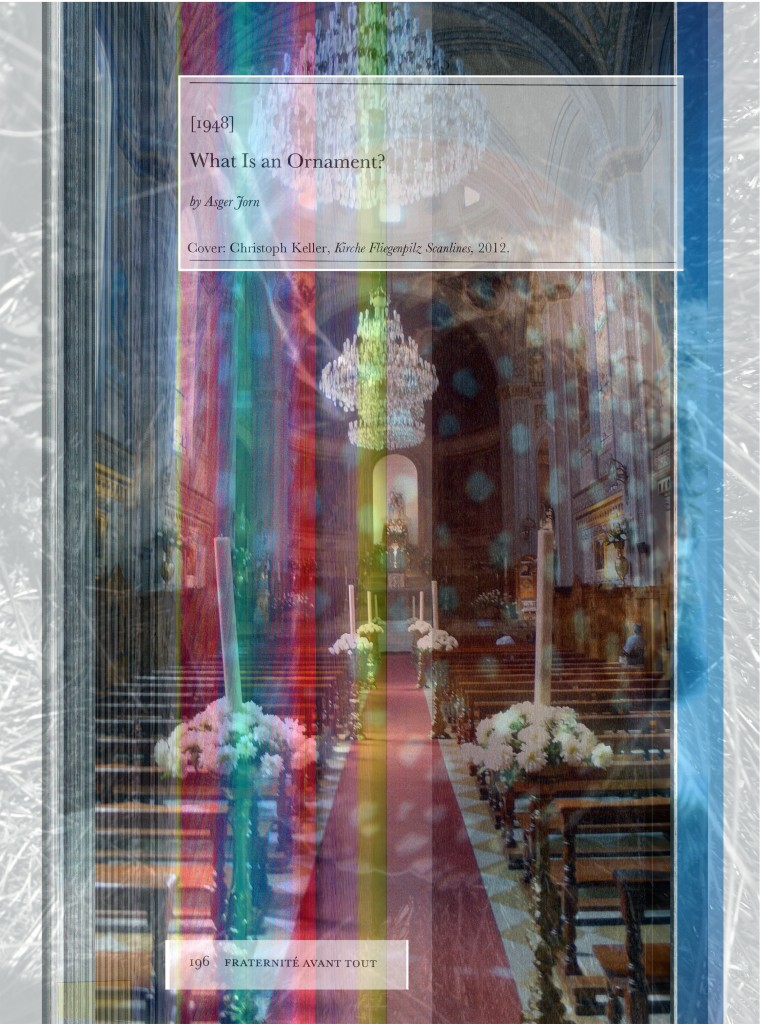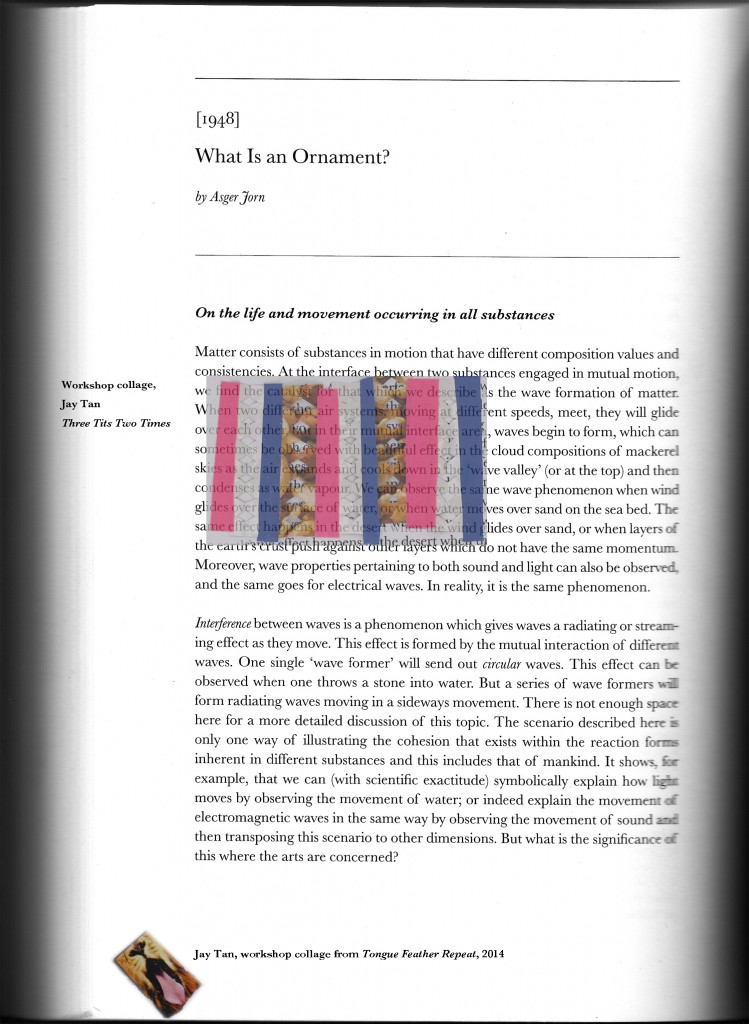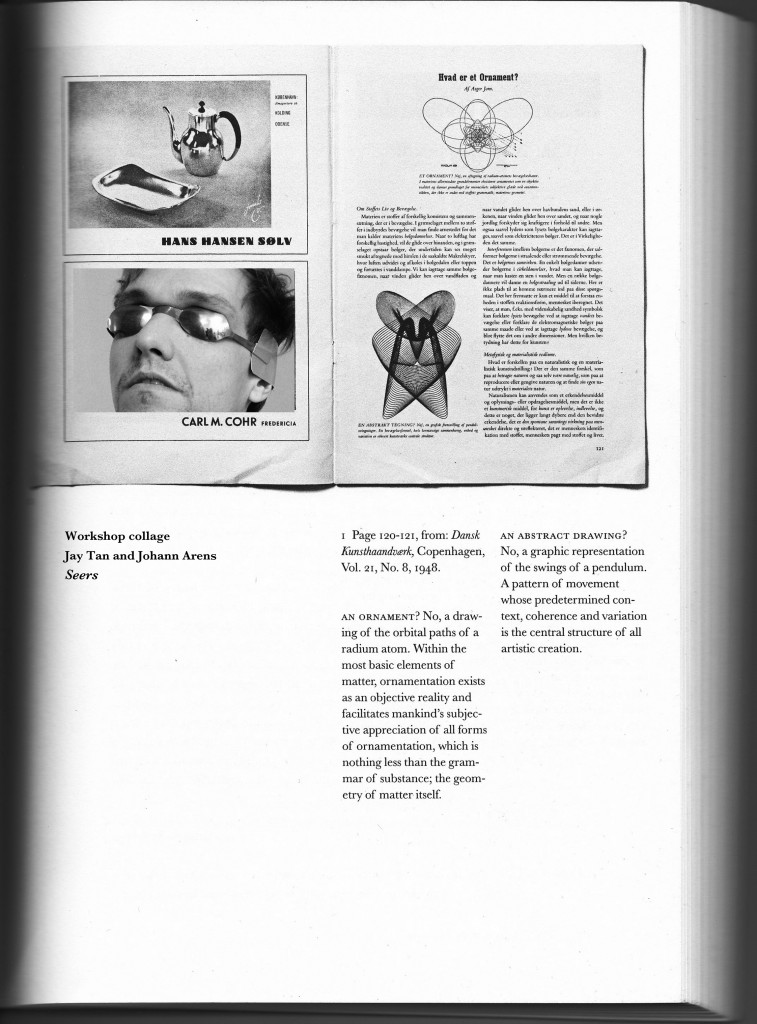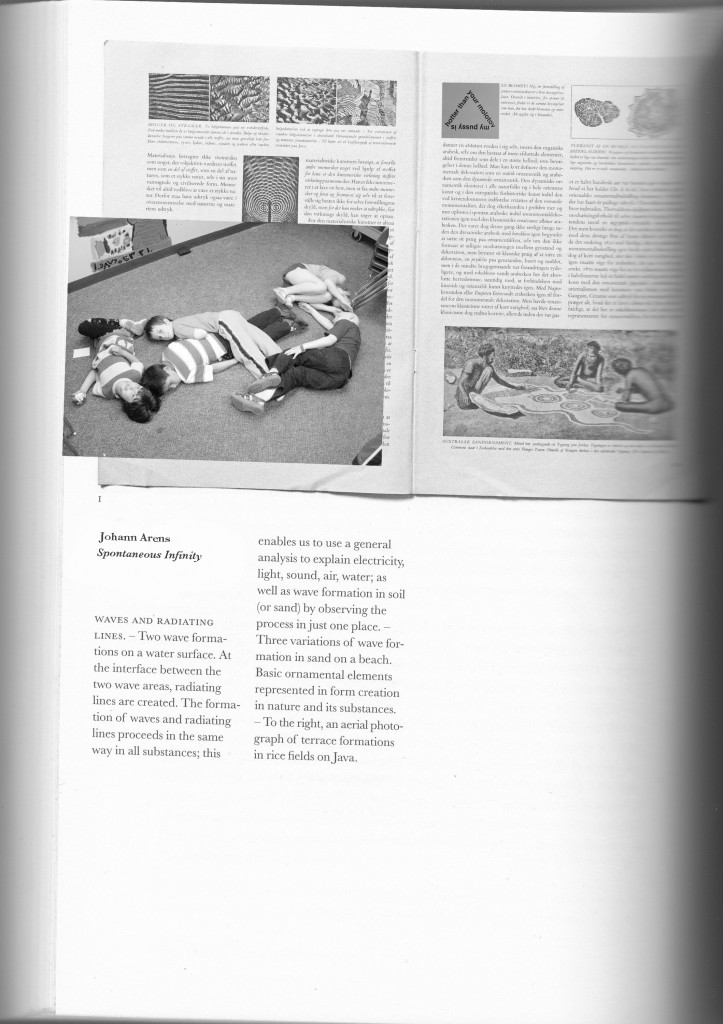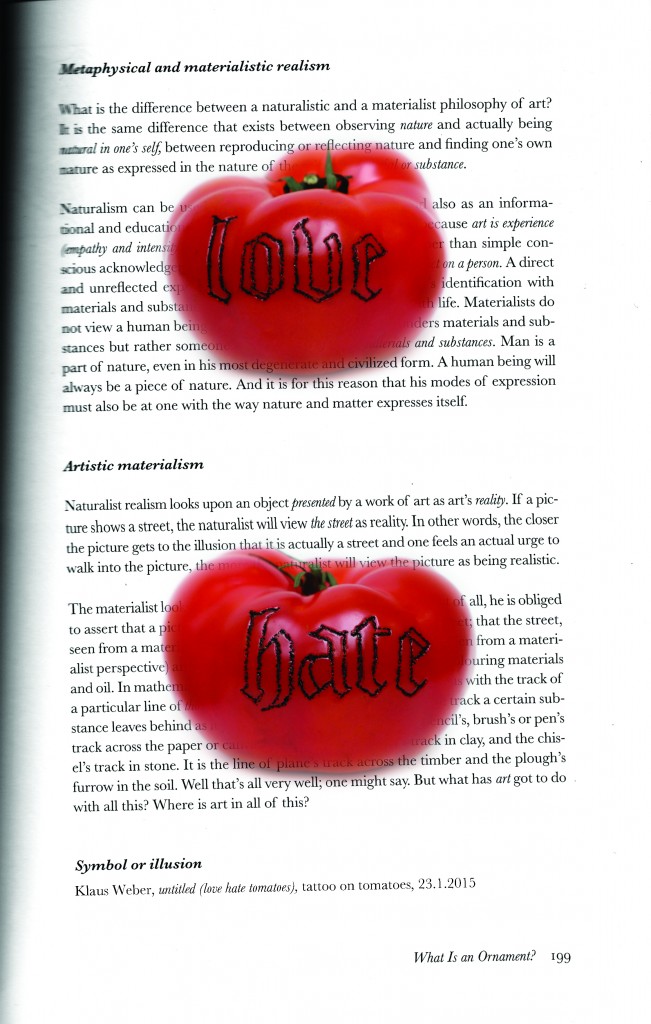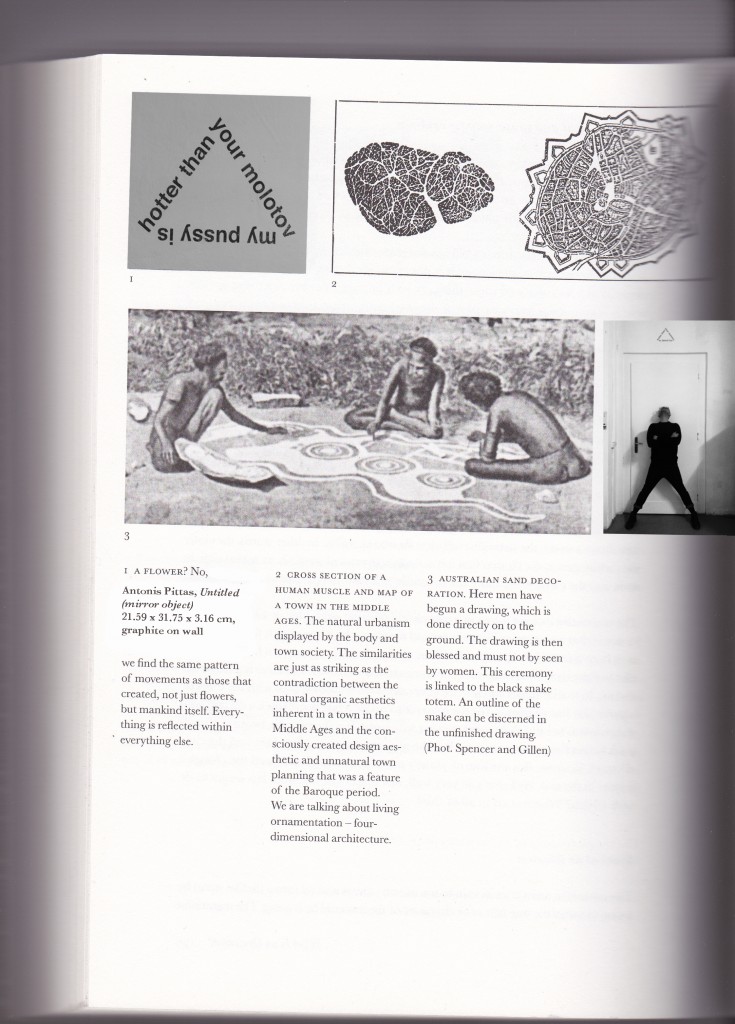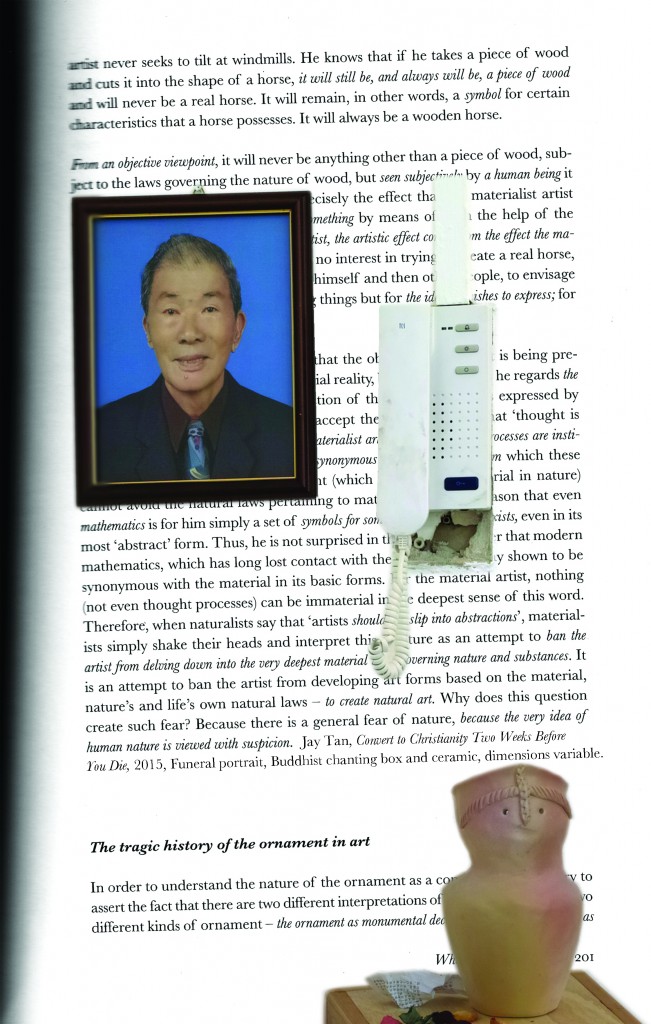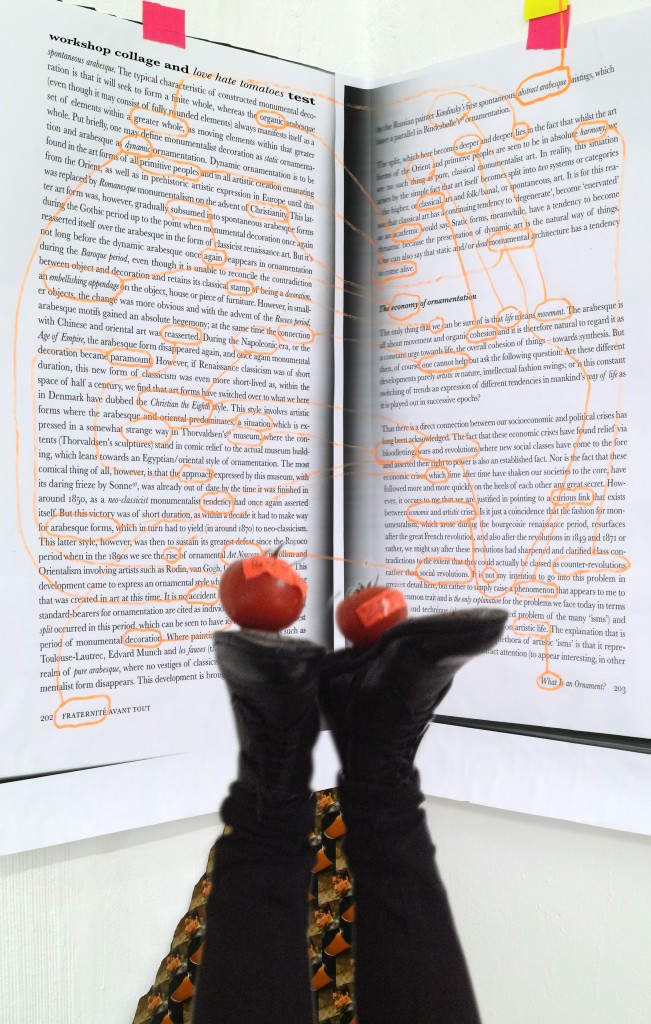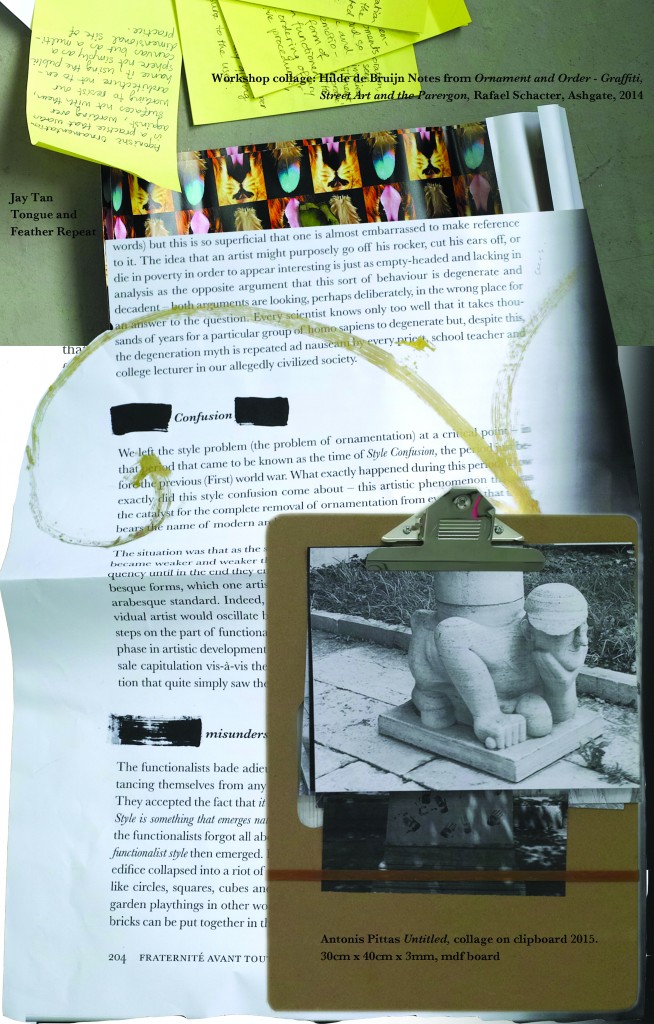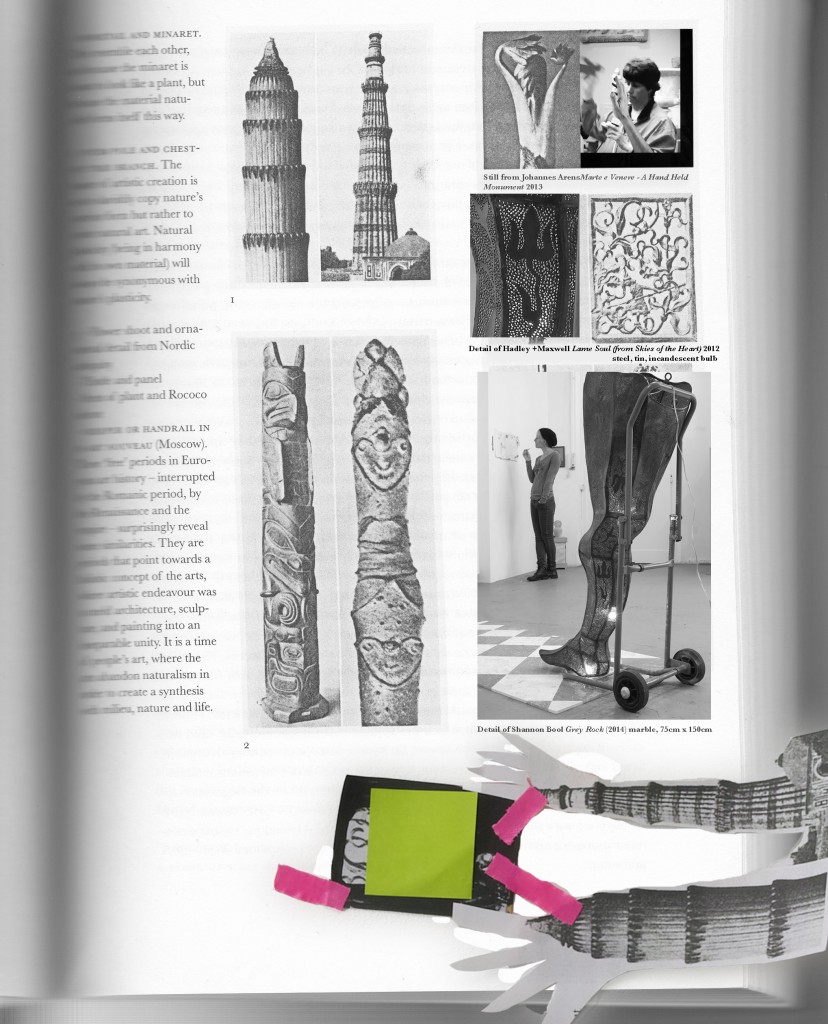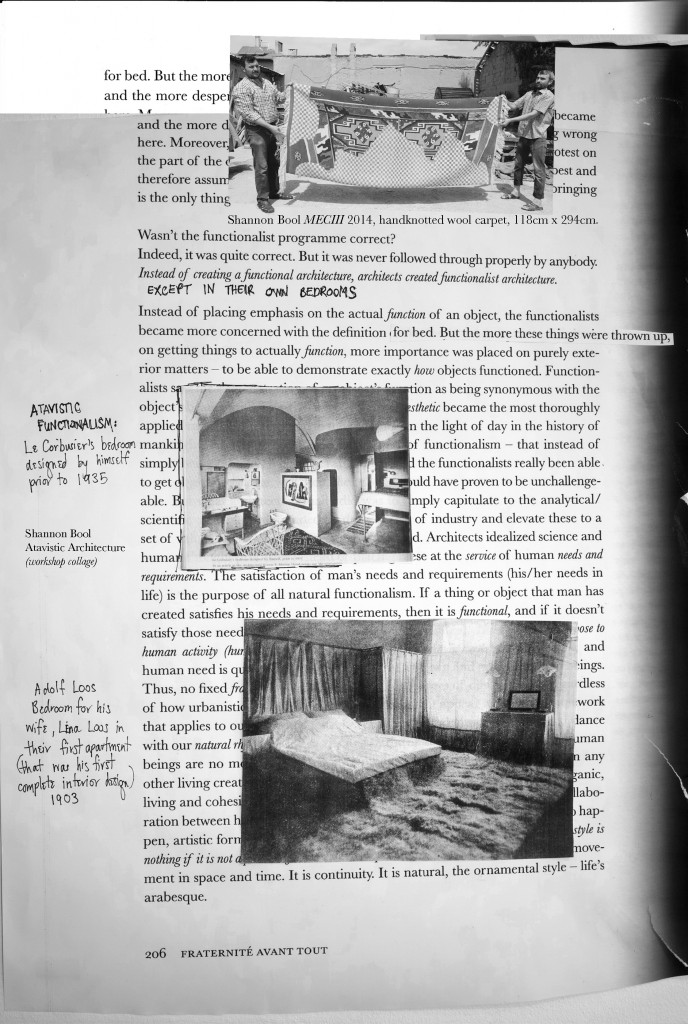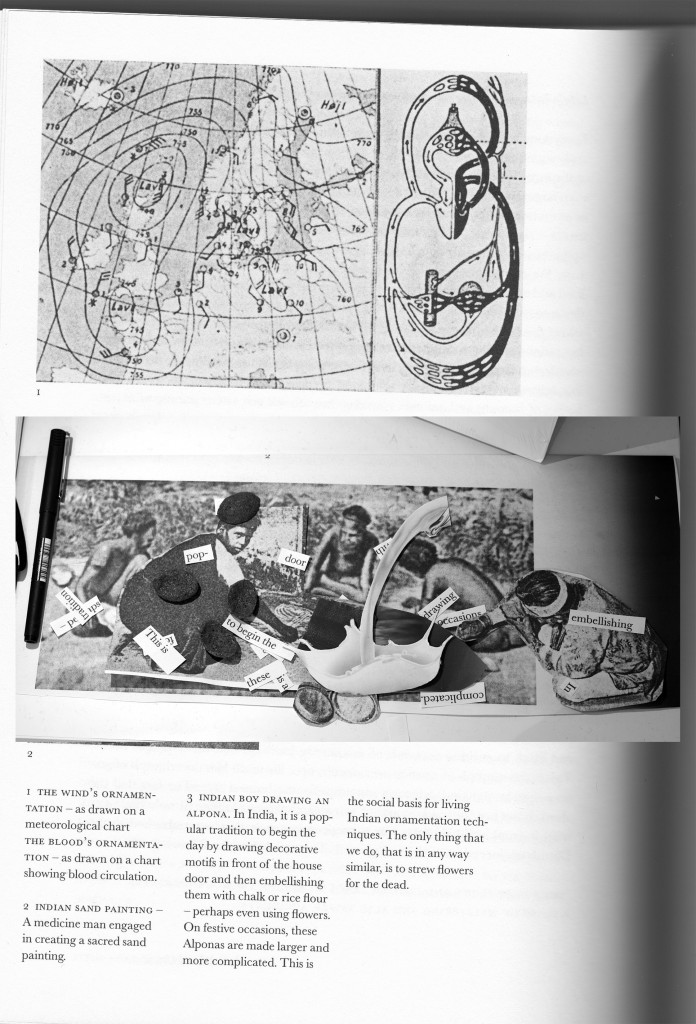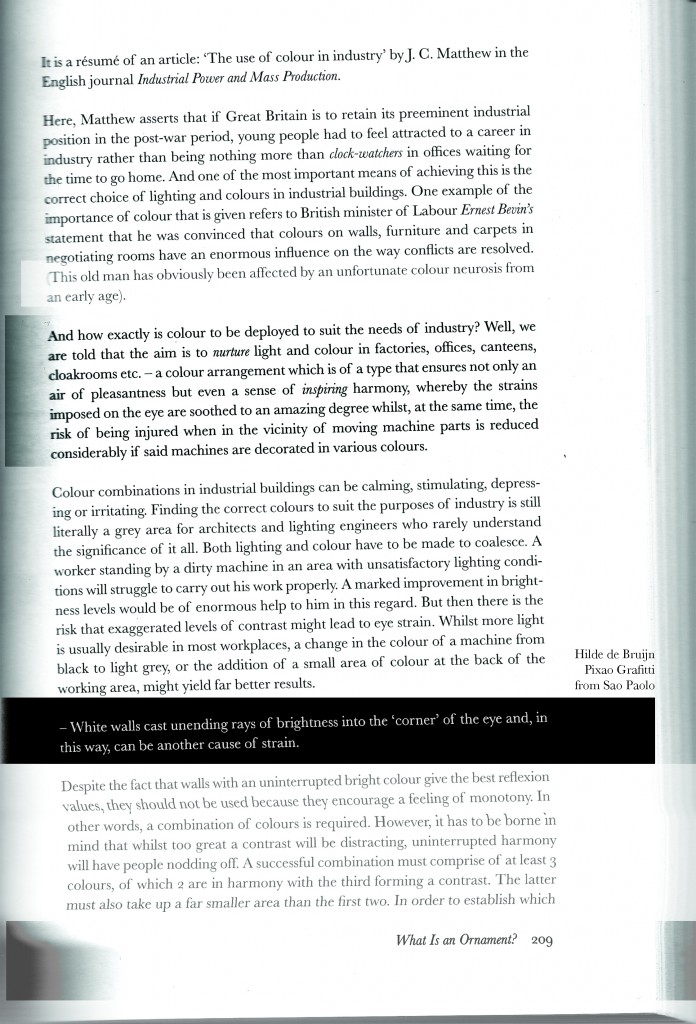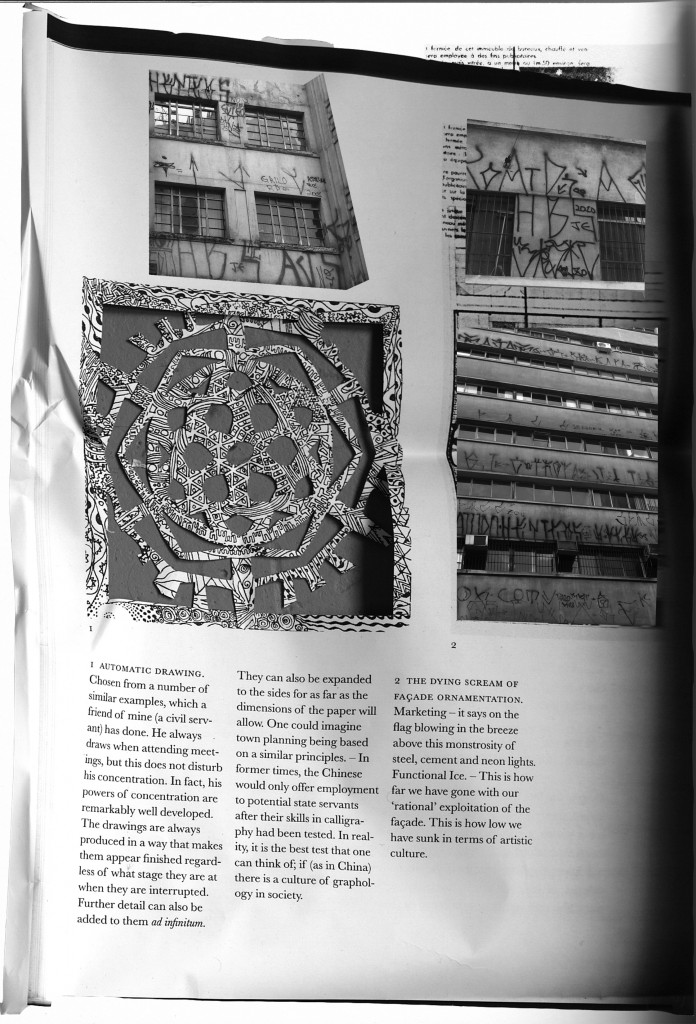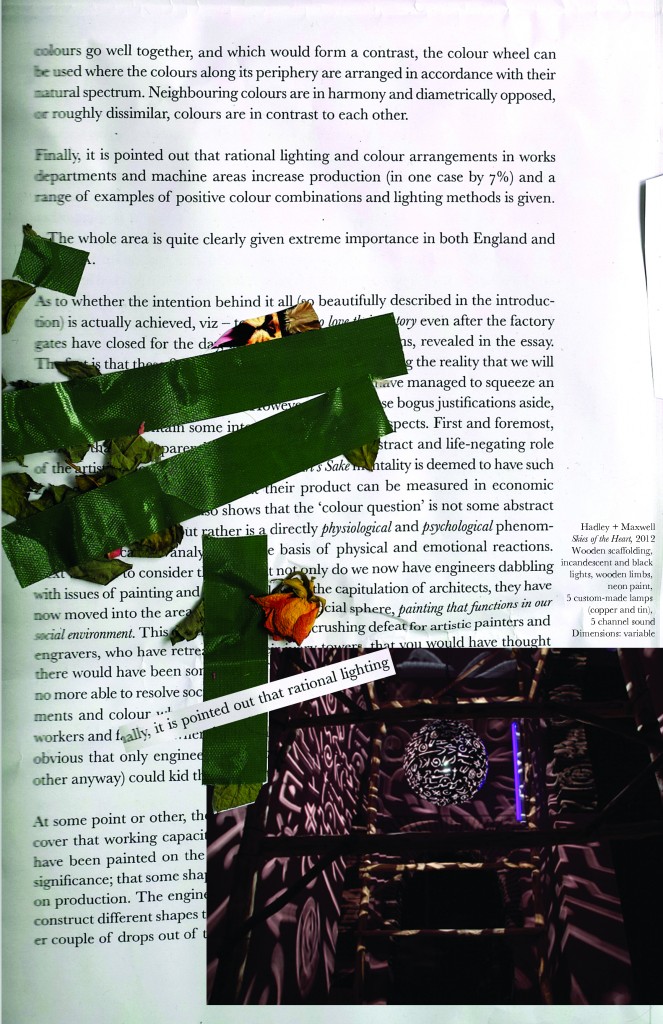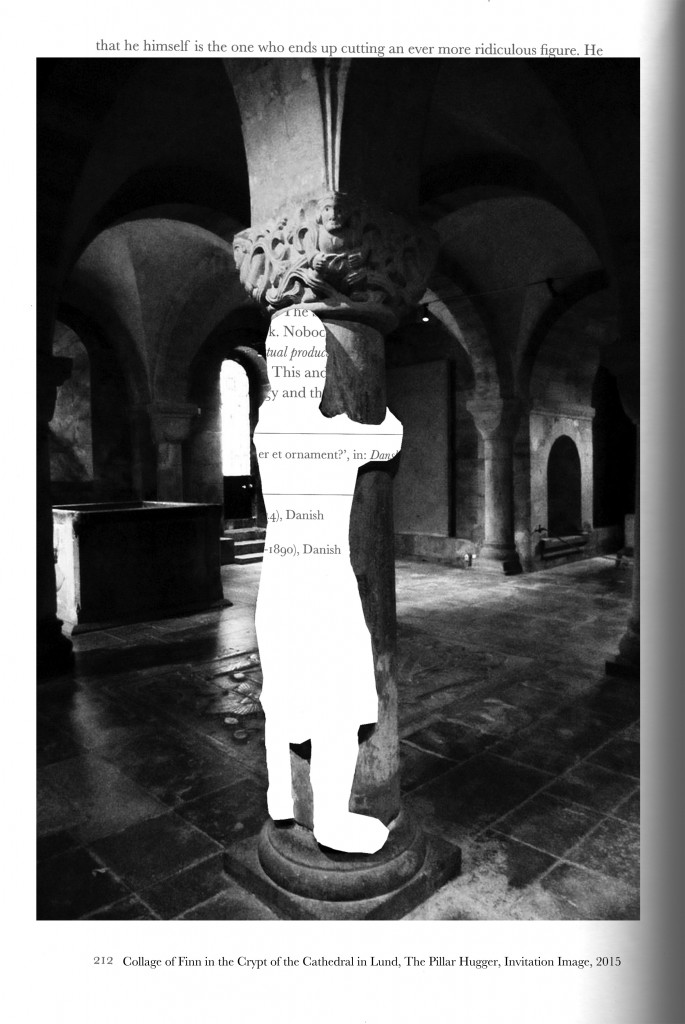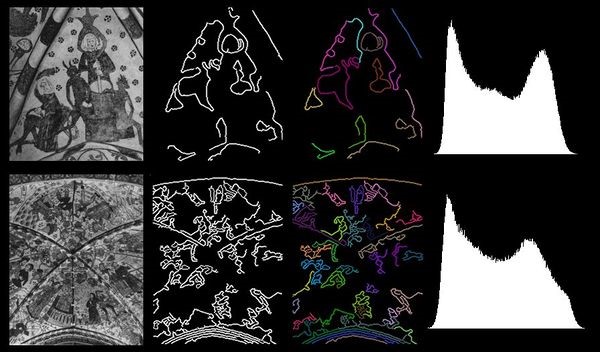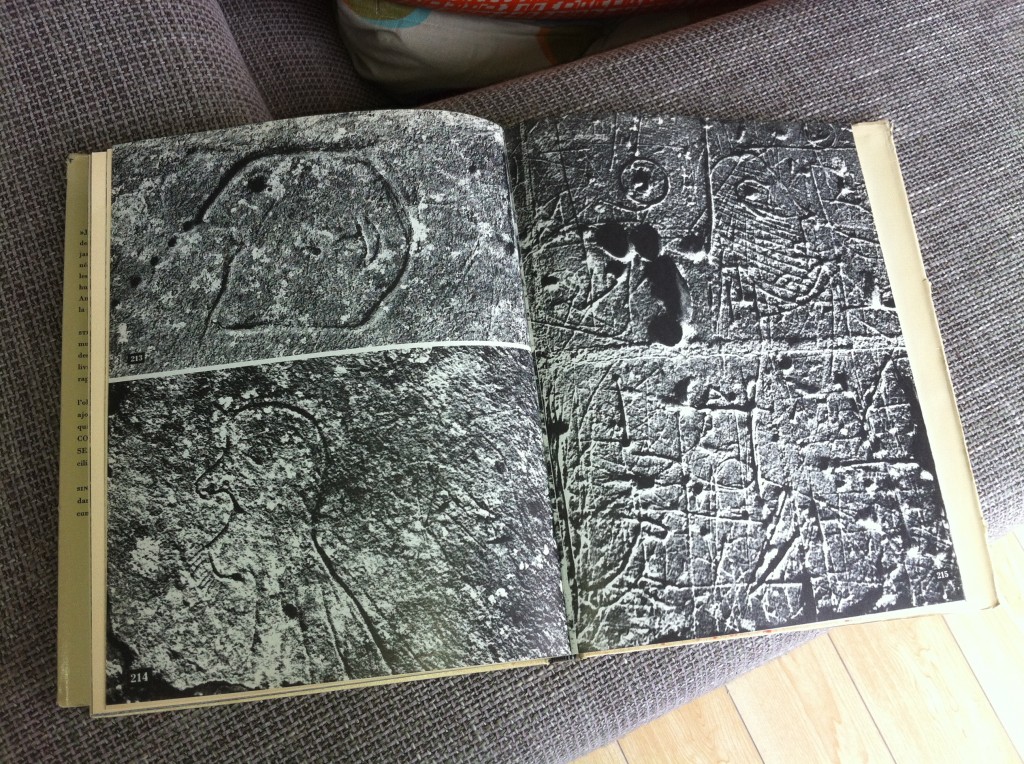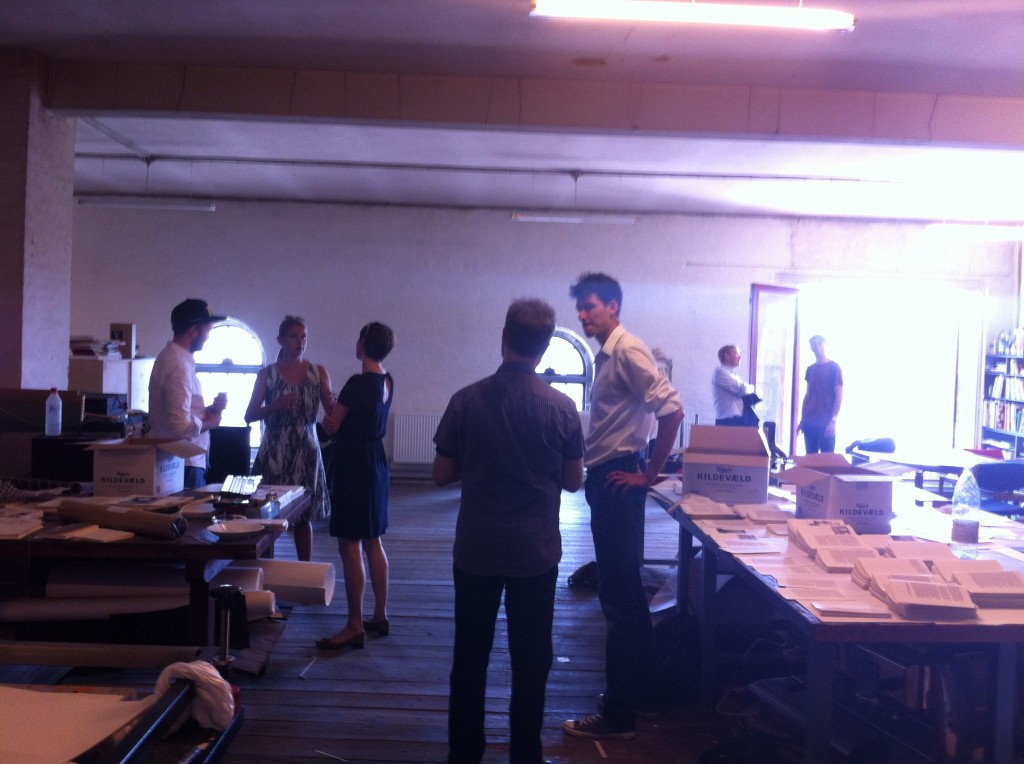YIANNIS ISIDOROU: WHAT ASGER JORN [UN]/TAUGHT ME – A TEXT OF 11 POSITIONS REGARDING THE MOVEMENTS AND TROPES OF THE ARTIST IN THE SYMMETRICAL(IZED) WORLD OF ECONOMY
Within the framework of my research into Asger Jorn´s writing and thinking I organize public and semi-public sessions with special guests at a variety of venues. The guest´s practice, knowledge, insights, or responses are informative to my research, or steer the direction I take on a particular topic. The sessions also often respond to the context of the hosting institution, or to a specific request. Making the sessions public is a way to share and enter into a dialogue with the audiences.
On January 8, 2016 the session ‘Asger Jorn: Thinking in Threes’ was hosted by Circuits and Currents, the Project Space of the Athens School of Fine Art. Two Athens-based artists contributed to this session. Kostis Velonis with the text ‘Alfred Jarry and Asger Jorn: the Epicurean Influence as Social ‘Swerve’ which can be found in the Pataphysics section of this blog, and Yiannis Isidorou with the performance-text below, which consists of a compilation of Jorn citations, partly shifting the original intentions as “to point out some extra risks of today”, to speak with Isidorou.
Yiannis Isidorou’s practice spans a broad range of media including photography, video, sound design and installation. He is co-founder and editor of the Greek e-magazine happyfew.gr on politics, philosophy and art. In 2004 he established Vortex Studio an independent art space and seminar center where he teaches photography and video. His latest project, another co-operation with Yiannis Grigoriadis, called “Salon De Vortex” is a thorough research on democracy, dominance and decay in the post war european society.
1.
Modern science makes us understand the true character of the machine, of rationalization and of standardisation. All of that leads to one thing only: the economy. Economy attempts (is) the symmetricalisation of forces.
Art is to create inequalities.
It is a way of breaking with common taste but also, of reconceptualising it by means of that break, it is a strategy of redescription and re-presentation , a process of hi-jacking. Criticism and affirmation coexist. Imagination, game, awareness, contingency, subversion of the existent.
Every conscious creative act concerns itself with the boundary of self-interestedness and aims at its rapture and containment.
2.
I remain unpredictable at every moment, create the preconditions for surprise and disturbance, I manoeuvre amidst the multitude.
The artist is a chameleon. Lives as the servant of the contingent and the infinite. Bases his cause on nothingness. Moves across the surface, to the margins or even beyond the space defined by consensus, ideology, the common view of things.
Art is not a standard of behaviour but a field of experience.
3.
The reconfiguring of the artist is possible and it is urgent.
What is at stake is a confrontation.
Living art signifies action, it is directly connected to deciding, it negotiates negation, it sets examples and examines multiplicity. The creator’s art is diametrically situated to that of the viewer, the reader etc. Uniqueness, inspiration, scintillation are now the empty signifieds of the dominant spectatorial conception of art. They are the narratives which uphold the ideology of the spectacle. / Art values reality, it is a value investment that reaches as far as the perpetuation of the moment. It renders reality precious in sharp contrast to technique, which disdains it.
The purpose of art is to render human actions valuable, using the means which the current development of the times affords.
4.
I loathe the stock values of the industry: “originality”, innovation, novelty and alongside those, their main instances in the 20th century – work camps, concentration camps and the atomic bomb.
Artistic experiments continue to exist, whereas an experimental field no longer does. That is being endlessly crushed between commercial pusillanimity, resentful controversy and academic hypocrisy.
More and more artists find themselves in an unprecedented impasse and are forced to beg the state for certification, become “prize pupils” and go after distinctions from opportunists the world over, presenting their wares to collectors, institutions, residencies and fairs. Forced to respond to the requirement of constant self-promotion, they regularly make fools of themselves and lose themselves in the neurotic need of acceptance by no-matter-whom.
We thus give away the most precious thing of all – our time.
5.
There is no creative-poetic activation except opposite of society. The social human remains man’s most convincing instance. Despite that / the generality of a social life cannot exceed the tragedy of a private life. Social meaning never does supersede individual’s.
The individual’s enmeshment in the contradictions of the real and its overcoming, reappear as one of the main areas of concern of free artists. A fragmented ‘I’ and a fragmented word may only encounter one another in a way that’s exceedingly contradictory and imponderable. No progress is possible without dire consequences.
6.
Artistic organization is impossible and irrational. Art is anarchy. It is a practice deeply antisocial and it resists organization.
The artist is anti-political. His practice refutes social organization.
It consists in the manifestation and renewal of value differences, hence is sharply at odds with the principle of equality. It attempts increments of progress by experimenting with the discreditation of the existent, without moral prejudice and without defined aims.
What the artist shares with those who are likeminded is the sentiment of rebellion which, however, is changed into a vacant stance (devoid of meaning) when (or as) it evolves into extremism. Every avaunt-guard declaration is finally an eschatology from which we ought distance ourselves, the sooner the better.
Enough already with groundbreaking practices.
The artist seeks the ties that bind the world together. In that regard, he has been abandoned to an apparently useless and futile struggle. Persistence is necessary in order to found a cause on nothingness, on the purely contingent, on the irrational, since wordly forces require a spiritual justification of their power. The ideal of the State.
The activity of the artist in relation to that coercion is the activity of the dexterous burglar-saboteur. He gains an overview of the area, assesses the risk, secures an escape route, works fast, minimizes the duration, blows everything up.
7.
Art is what is discontinuous within the continuity of the world’s narrative. It is an ensemble of incisions and methods whose horizon is the autonomy and freedom of the individual and whose field of development is social becoming.
It is proof of the individual capacity for free action and simultaneously the main means of increasing public nervousness and releasing man’s available energy tensions. Tolerance is the one thing not tolerated in the artistic field.
The construction and projection of a theory of the restrictions, rules, principles or causes for which I create, in short, a narrative of the process of the artistic work, has a soporific effect and, in any case, it lapses into a didactic subterfuge, an educational obstacle on the way to autonomy, to the understanding of social requirements and possibilities of the times. Every promotion of the process ends in pathetic introductions and afterwords.
8.
Availability is the precondition of self-ordained creative activity. Those who have everything to gain and nothing to lose are the artists who are today virtually the only group in the population who retain their total availability unaffected. Several ruses have been enlisted to rescind that availability the outcome is that, even if “artistic production” keeps up, it is void of artistic value.
For the artists who have preserved their free availability and creative capacity, life becomes increasingly dire. One might speak of homelessness. Whoever today chooses or answers the call of free creation, must be prepared in advance for relentless persecution, malignment, pressure and, in the event these do not have the desired effect, lawsuits.
9.
We do not pick our time even if we transform it.
Europe’s cultural production is strictly separated from its society and functions as a central propaganda machine of reality reversal. It is an obscurantism claiming to be an enlightenment. Academia as a movement remains a staunch enemy of art and of the artist. We do not oppose the schools of craft production nor the Fine Arts academies. They are not our concern.
The free artist is a professional amateur. The spirit of amateurism does not signify one is a complete autodidact but, rather, the capacity to overcome one’s knowledge in favor of a new innocence, a new zero starting point or a sense of utter ignorance. Art never provides values but consists in the power necessary to affect and release the ones existing. That is to say, it is a destroyer of human quality and integrity and it is this destruction of perfect integrity that is experienced as beauty. The secret of art consists in the simple fact that it is more beatific to give than to receive but this beatitude hinges on a voluntary offer, on the sense that the offering is considered to be surplus, an abundance and is not motivated by a sense of duty. Art destroys, subverts, liberates.
Oblivion remains our foremost passion.
10.
Only changes attract people’s attention. Creating changes is what is called a game or a variation. To establish a field that operates on the principle of necessity is to annul the possibility of a game or of variations within it.
The game may be considered the foundation of what we call fine arts and this is due to the attraction exercised by the risks to which we are exposed in the course of the game, an attraction requiring an optimal concentration of skill to attain optimal performance.
Only through high stakes may optimal performances derive.
11.
Loneliness is lying in wait for the artist.
During the game, during the concentration of individual skills there are many dangers. The “game” is a closed off narrative.
By contrast to the vastness of the real, it starts, it ends, it has rules.
Life goes on.

In 1964, Asger Jorn was awarded a Guggenheim Award including a generous cash prize, by an international jury assembled by Lawrence Alloway. The following day Jorn sent this telegram to the president of the Guggenheim, Harry F. Guggenheim : GO TO HELL BASTARD—STOP—REFUSE PRIZE—STOP—NEVER ASKED FOR IT—STOP—AGAINST ALL DECENCY MIX ARTIST AGAINST HIS WILL IN YOUR PUBLICITY—STOP—I WANT PUBLIC CONFIRMATION NOT TO HAVE PARTICIPATED IN YOUR RIDICULOUS GAME.
KLARA LIDÉN, PILLAR HUGGER
In 2012, when I applied for a so-called mediators grant to support a curatorial research into Jorn’s writing and thinking I played around with the idea to look at the work of the Swedish-born contemporary artist Klara Lidén (1979) through the lens of Asger Jorn’s ideas on vandalism. Now, 4 years later, Zoë Gray, Senior Curator at the centre for contemporary arts Wiels, in Brussels, gave me the incentive to finally do so for a lecture in the framework of the exhibition Klara Lidén: Battement battu (29.10.2015 – 10.01.2016). The text is a slight adaption of the lecture that I held on January 6th, 2016 at Wiels. I would like to thank Zoë Gray, and I would also like to thank a range of art historians and other Asger Jorn specialists whose perspectives have been highly informative to this lecture including Ruth Baumeister, Helle Brøns, Niels Hendriksen, Karen Kurczynski, and Peter Shield.
Asger Jorn
Let me introduce the first one of the protagonists of this lecture in more detail: the Danish experimental artist and thinker Asger Jorn (1914-1973) was one of the founding members of the Danish Høst group (1934-1950) and the associated magazine Helhesten which he founded (1941–44); the international experimental Cobra group (1948-1951); the Movement International for an Imaginist Bauhaus (1953); and the Situationist International with among others Guy Debord (or SI, 1957–1972), and the Scandinavian Institute of Comparative Vandalism (1961-1965).
To Jorn’s own way to go about we could certainly attribute ‘vandalistic’ tendencies: he would cut out images, scribble or underline passages in his own books (as well as in the books of others), he would buy bourgeois, academic style Sunday school paintings at the flea market and alter them, he would for several years in a row go back to the house of the collector of his largest painting to continue altering the painting because the buyer had made a comment about the work perhaps ‘still missing something’, he would run a scooter over a large clay relief leaving the tire track visible in the end result, and he would tear down tick layers of posters in the streets of Paris to ‘décollage’ them.
Even the way that Jorn used photography in for instance his book Signes gravés sur les églises de l’Eure et du Calvados (1964, on mediaeval graffiti on churches in France) has been labelled ‘vandalistic’ for the continuous disconnection of the photographs from historical chronology in favour of a purely visual order (Niels Hendriksen).
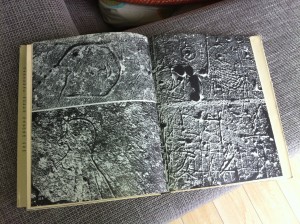
Asger Jorn, Signes gravés sur les églises de l’Eure et du Calvados, 1964
Klara Lidén
Protagonist number two is the Swedish artist Klara Lidén (1979) who lives and works between Berlin and New York. Lidén works with performance, interventions, video, installation and sculpture. Her main interest is an exploration of the physical, psychological and social limits and conventions of both public and private space; the street as an endless source of inspiration and action; an obsession with recycling and transforming urban materials; physical gesture and use of the body. She has recycled waste packaging into makeshift hideaways, turned old posters into paintings, along with many other kinds of creative vandalism.
Like Asger Jorn’s décollages, Lidén’s Poster Paintings series consists of layers of glued-together advertisement posters taken from the streets, but in contrast to Jorn who reveals so to speak hidden compositions, Lidén’s sole addition is a white top sheet. A series of spray-paint works on paper by Lidén show traces, prints of everyday life items that the artist finds in her studio or among her personal belongings, including her bike. Again an image that reminded me of Jorn, of his clay relief.
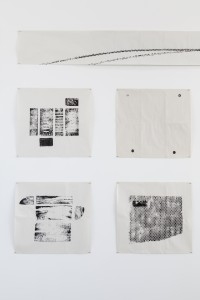
Overview of various works on paper with spray paint by Klara Lidén, exhibition detail, Wiels, Brussels, 2015.
Lidén’s photograph Bowery (2012), showing a figure that has climbed on to a street sign at an intersection; and Column Monkey (2013), in which we see how she ascended on the pillar of a deserted building in an urban zone reminded me of images in one of the publications of Jorn’s SISV.
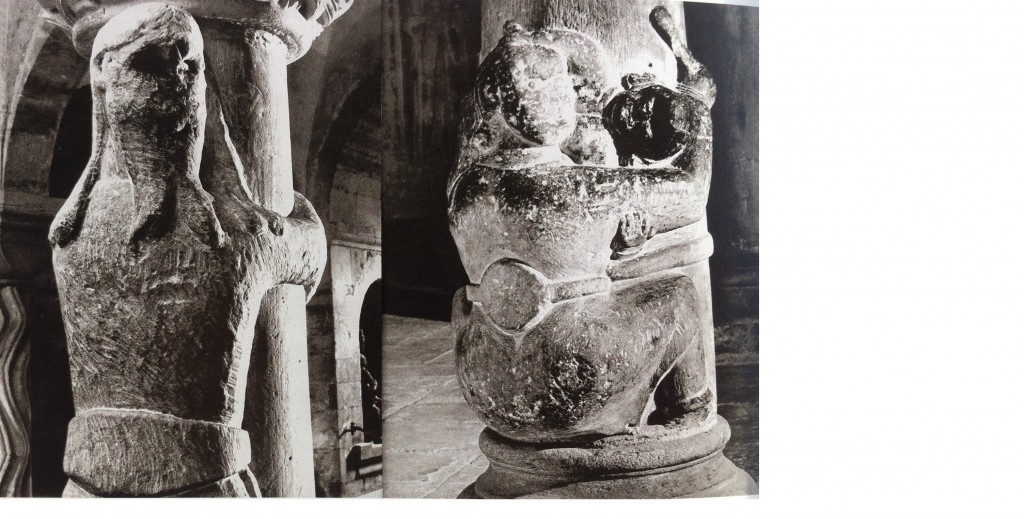
Pillar-breakers or pillar-huggers at Lund Cathedral, photograph by Gerard Franceschi in Jorn’s publication “Skånes stenskulptur under 1100-talet” (12th-Century Stone Sculpture of Scania), 1965.
JORN ON VANDALISM
Not only did Jorn display a ‘vandalistic attitude’ within his own art practice, throughout his writings he also theorized on the concept of vandalism but of course, the concept is part of a web of other notions, and I decided to simply take a few of these as a starting point for further analysis and speculation.
Value
In relation to the notion of value I would first like to bring up the vocabulary of the Situationist International, which happens to be frequently mentioned in relation to Klara Lidén’s work – especially the notion of détournement. Détournement is usually translated into English as ‘diversion’. An English translation of the Situationist publication Détournement as negation and prelude[1] (originally published in French in 1959) says: “Détournement, the reuse of preexisting (artistic) elements in a new ensemble, has been a constantly present tendency of the contemporary avant-garde, both before and since the formation of the SI. The two fundamental laws of détournement are the loss of importance of each detourned autonomous element — which may go so far as to completely lose its original sense — and at the same time the organization of another meaningful ensemble that confers on each element its new scope and effect.”
Artistic examples of detourned expression include Jorn’s previously mentioned modifications, his altered Sunday school paintings. As Karen Kurczynski writes in The Art and Politics of Asger Jorn, with these kind of works “Jorn expressed an overt critique of the social exclusivity of high art from classicism to modernism and beyond.”
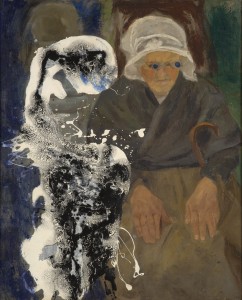
Asger Jorn, Modification with Brittany Woman, 1962. Collection Cobra Museum of Modern Art, long-term loan by Karel van Stuijvenberg,
On the occasion of an exhibition of these type of paintings, Jorn wrote: “In this exhibition I erect a monument in honor of bad painting. Personally, I like it better than good painting. But above all, this monument is indispensable, both for me and for everyone else. It is painting sacrificed. This sort of offering can be done gently the way doctors do it when they kill their patients with new medicines that they want to try out. It can also be done in barbaric fashion, in public and with splendour. This is what I like. I solemnly tip my hat and let the blood of my victims flow while intoning Baudelair’s hymn to beauty.”[2]
But despite this colourful remark, Jorn’s ‘vandalistic’ approach was never aimed at one-dimensional disrespectful destruction. This is also illustrated well by something else Asger Jorn said about his modifications in the same text:
Be modern / collectors, museums / if you have old paintings / do not despair / Retain your memories / but detourn them / so that they correspond with your era. / Why reject the old / if one can modernize it / with a few strokes of the brush. / This casts a bit of contemporaneity / on your old culture. / Be up to date / and distinguished / at the same time. / Painting is over/ You might as well finish it off / Detourn (détournez) / Long live painting.
Contemporary art historians tend to think of the modifications as re-valuations, or as “progressive use of tradition”. As Helle Brøns points out Jorn fully recognized that the creation of new values by devalorization is only possible where there is something to de-valorise, i.e. where a recognized value already exists. Brøns: “There is a fundamental difference between Debord’s attitude to the détourned material as something losing its significance, and Jorn’s maintaining – in part – its original value.”[3]
An artistic example of the use of detourned expression in Klara Lidén’s work could be the previously mentioned Poster Painting series. The posters lose their autonomy, and the reorganization by the simple gesture of adding a blank top sheet undermines their presumed message. The title of these works make a general reference to painting, the blank top sheet suggest a particular reference to the tradition of the abstract monochrome in modernism, the ‘upgrading’ of street posters to ‘high art’ could (as was the case with Jorn) be read as an overt critique on the social exclusivity of high art.
Below, I will discuss the next point that is also intertwined with Jorn’s thinking about vandalism but that leads to a pointing at some fundamental differences in Jorn’s and Lidén’s respective practices.
Progress
In Jorn’s texts the complete freedom required to create pure experiment, and the transgression of existing modes of thinking and pre-established norms and ideas, are inextricably linked to the notions of progress (and risk). In his text ‘Charms and Mechanisms – upon the role of vandalism in the history of arts’ (published in French in 1958 in his collection of essays Pour la Forme (the first substantial publication within the Situationist International) Jorn also brings up the example of the testing of new medicine (like with the detourned paintings when he speaks about “the blood of my victims”). He uses this example to illustrate the fundamental idea that risk, the notion of loss (or potential loss) are in fact an intrinsic part of progress. “I wager this clear idea”, Jorn says: “that there will never be any progress without tragic consequences. The gamble with life is the origin and the price of all progress.”[4] In other words: all progress is vandalistic and barbaric.
So what else does Jorn’s perspective on progress entail? In Charms and Mechanisms he states that he believes in progress, but that as an artist he rejects “any ethical interpretation of progress understood as moving towards happiness, justice or whatever.”[5] Jorn’s rejection of this interpretation might have been influenced by the Danish philosopher Kierkegaard, whose writings Jorn was very familiar with, and who belongs to a generation of thinkers who, I quote the Finnish philosopher Georg Henrik von Wright: “in the course of the nineteenth century had clearly distanced themselves from the idea of the myth of progress” and who according to Von Wright were “not necessarily pessimistic but in a sombre mood of self-reflexion and questioning of dominant currents of their time.”
Based on this more critical attitude, Jorn’s take on progress is instead, I quote: “(…) simply the feeling one has when one moves forward, on a train, for example, and sees the countryside disappear in the opposite direction. The feeling of progress implies losing something while gaining something else.”[6] “It is only by change, that is to say by movement, that the notion of time is available to us … If there are no events there is obviously no sequence, and consequently no time.”[7] According to Jorn, it is the direct goal of the arts to create these events – it is the speciality of the arts to do so. In his own practice this meant that he always aimed to create what he called “the greatest sensorial significance” by varying and diversifying processes.
Despite his rejection of the idea that progress necessarily implies improvement, one of Jorn’s motivations to write Charms and Mechanisms stems from a concern over the declining power of the human race to evolve. In our struggle for reason, we are abandoning this power, Jorn says, by “giving up all irrational or artistic activity in the sphere of the imagination” – whereas it is exactly this activity that generates new knowledge, artistic knowledge[8] (which Jorn also refers to as “comprehension without recognition”).
The Myth of Progress
Klara Lidén has been preoccupied with the notion of progress as well, as is illustrated in the titles of some of her works and the title for her solo exhibition, at the Irish Museum of Modern Art in Dublin in 2014: The Myth of Progress. She took the title from an essay by the aforementioned Finnish philosopher Georg Henrik von Wright (1916 – 2003).
As Jacques Bouveresse points out in his article ‘Wittgenstein, von Wright and the Myth of Progress’[9] Von Wright wasn’t critiquing progress itself, but critiquing the idea that progress is unbounded and everlasting, natural and necessary, and that this type of progress is inscribed in the nature of human beings as a species. Bouveresse quotes Von Wright: “(…) we may seriously wonder whether the idea of unlimited progress, understood in such a way, is not liable to enter into contradiction at some point with the natural species itself, which necessarily implies an environment and living conditions which must also remain, at least to a certain extent, natural, and cannot be transformed in any way we could like and without any limits.”
In contrast, Asger Jorn is aware of the risks that come with progress (its ‘vandalistic’ aspect), but accepts the risk, while maintaining a desire for, or a belief in progress. In his artistic practice this translates into an experimental working method based on bringing about variation and diversification. Large parts of his artistic output, consist of taking existing elements and altering them, resulting in a new objects that now say something else. Think of his modifications, or of his décollages.
In comparison Klara Lidén, who we could argue lives in a world that starts showing the actual consequences of unlimited progress, seems to add just the minimum to a world already overloaded. There is a stronger focus on conceptual, minimal gestures such as with the stacked pieces of asphalt, or with the Poster Paintings: when Klara Liden takes a thick layer of posters from the street and alters it, strictly speaking, she doesn’t add another/her own voice, she rather mutes the original message.
Or, where Lidén leaves a modest bike tire trace on a piece of paper, Jorn leaves behind the noisy tire track of a scooter on the largest clay relief in Europe (27 meter); where Jorn has written hundreds of texts and engaged in public discussions, I can only find a modest amount of interviews by Klara Lidén, and where Jorn co-established various artist groups all trying to raise their voice, always discussing and debating, also amongst themselves, we see Klara Liden on her own, or as a solitary individual even if amongst a group of other people (such as in her well-known video Paralyzed, 2003, in which she does a wild, uninhibited dance on a commuters train in Sweden). In conclusion, I would like to speculate that it is perhaps Jorn’s and Liden’s respective perspectives on the notion of progress are accountable for these kind of differences in their artistic output.
I will now jump to the last notion that is closely related to Jorn’s ideas on vandalism, which is the notion of resistance.
Resistance
From an intellectual point of view Jorn was interested in vandalist expressions as acts of resistance against the reigning order: the graffiti that he found on the churches in France was supposedly made by Viking “vandals”, and the book 12th Century Stone Sculptures of Scania is emblematic for the SISV approach by demonstrating a subtle subversion of the iconography of power. This aforementioned book which includes the image of the pillarhuggers/breakers traces the infiltration of a non-Christian iconography of beard-pullers, double-heads and pillarhuggers in the decorative programs of churches built in the aftermath of the annexation of Scania by the recently converted kingdom of Denmark around the year 1000.
The subversion of existing hierarchies and power relations runs through Jorn’s thinking and practice as a red thread. In Charms and Mechanisms, when Jorn speaks of what distinguishes the artist from “his adversary” he characterizes the artist as the one with conscious opposition to the reigning order in life and places what the calls the “grotesque folly of a too probable existence played out in advance” in direct opposition to the “pure desire for the unexpected, the thirst for surprise, the longing for the absurd, and the attraction of the abnormal, in short, towards diversion, amusement, the ‘dérive’.[10] And a bit further on he writes: “all artistic structurations are just different forms of networks of resistance against movements. (…) all we need to point out here is that artistic currents cannot, as imagined by politicians, serve directly to unify and accelerate general social movement. On the contrary, as counter-currents they are engaged in enriching, diversifying and enlarging the importance of an existing movement by diverting it.”[11]
What speaks from these citations is Jorn’s love for dialogue between a plurality of voices, which is not only part of his thinking, it is also expressed in the collaborations that he was always looking for. To Jorn the dialogue with others, whether harmonious or conflicting, was never supplementary or subsequent, but foundational to his practice and the way he dealt with art as a public phenomenon. Within these collaborations Jorn was fiercely opposed to watered-down consensual results. He believed that consensual strategies needed to be avoided in order for everyone involved to give their very best. The dialogues that Jorn was looking for, were of a more polemic, combative nature. In contemporary terms we could perhaps even speak of Jorn’s attitude as agonistic. “Within agonistic theory disagreement and disputation as deemed necessary, rather than negative components of political and social life”, they are considered “constituents that are at the foundation of an active, vigorous instantiation of citizenship. Within this conception of the public sphere no boundaries or borders can remain unchallenged.”[12]
In conclusion we could say that Jorn, who despite his statement about the rejection of an ethical interpretation of progress, is still driven by the idea that artists and architects could potentially make a difference, testifies of a resistance that is so to speak ‘loud’. In contrast Lidén’s seems a mute resistance, perhaps even totally devoid of risky dreams of a better world. As Helen Molesworth writes in an excellent article in Art Forum when discussing Lidén’s practice: “the artist at work is imaged as silent, sullen, solitary, and quite possibly self-defeating.”[13] Molesworth speaks of a “muted, nearly autistic sensibility” in relation to Lidén. But what does that imply in regards to the notion of resistance, of critique in her practice? Obviously she is not looking to argue, to engage in an active, vigorous instantiation of citizenship ….
Perhaps we should take the term postcritique, a notion that was brought up by Helen Molesworth in the same text, into consideration. The way I understand the term postcritique (though admittedly based on very limited knowledge), suggests that Lidén belongs to a generation that is critical of universal normative principles. A generation that as such is not primarily concerned with these, whereas nevertheless looking for the possibility of critical resistance to moral and social ills. However, as David Couzen Huoy points out in his book Critical Resistance – from Poststructuralism to Postcritique the type of resistance, the in-your-face refusal, exemplified by the famous students uprisings in Paris in May 1968, in which the Situationists International played such a preponderant role (to some extent their political perspective and ideas fueled such crisis), has been replaced by another. The ’68 motto “we are realists, we demand the impossible” nowadays simply means “to resist globalization of capitalism even when one does not have a better alternative to offer” (here Huoy sketches the perspective of Slavoj Zizek).
This perspective might offer an explanation of why Florence Waters in a 2010 review in the Telegraph on Klara Lidén’s solo show at the Serpentine Gallery felt compelled to write that it: “(…) is the knowing futility of Liden’s gestures that separates her from the previous generation of art vandals.” And that, “Unlike her forefathers, Liden’s message is too suffused with irony to be political. She seems, almost, to be poking fun at her predecessors (…) for the naivety of the idea that art would be grand enough to really change anything.”[14] Also Helen Molesworth discusses some of Liden’s works as “the staging of what may be the central dilemma of today’s emerging artist: the futility of being one in the first place.” She writes: “And spending time with her work, one realizes that the twentieth-century paradigm of art’s utopian aspirations is not what’s at stake. Lidén offers blankness—and its aural handmaiden, muteness—less as a critique or a way out than as a condition, less as a program than as a given (reduce, reuse, recycle). In her work, I sense a tacit acknowledgment that the jig is up, that being an artist is just another way of getting by, a coping strategy for living under late capitalism.”[15]
Perhaps this ‘just another way of getting by attitude’ (I’m sure that I’m making it sound more negative then Molesworth intended) is a justified observation. I can see why it would be. I can then also see how this attitude is ground for critique that was expressed in a review in Frieze of a group show in which Lidén was participating. In the article some of her work, as well as that of some other artists, was criticized the following way, I quote, “the pointing towards resistance and subtle undercurrents of violence became the objects of aesthetic contemplation.
This was palpable in Klara Lidén’s series of framed black and white photographic prints, including Untitled (Down) (2011) and Untitled (Monkey) (2010). In these images, a distant person traces alternative routes through the city, up concrete pillars and down manholes. These works did not merely speak of an aesthetic of revolt, but also of the fetishization of resistance.”[16]
But I am having a hard time to buy the ‘just another way of getting by attitude’. Perhaps I simply find it too depressing, but I also guess that there are much much easier ways of getting by then being an artist. And funnily enough, the works criticized in Frieze magazine, are pretty much the same works that led Darran Anderson in a passionate and positive review of Lidén’s solo exhibition at IMMA to conclude that she “demonstrates that we can resist through small imaginative acts of revolt, or at least express our alienation.”[17] Anderson brings up the humorous aspect of the work, as well the notion of danger and risk (public ridicule, attention of authorities, physical harm). And he speaks of how in these works, Lidén’s presence in public space communicates that “any attempt at individuality or real interaction with the surroundings will have stern and immediate consequences”. Crucially, Anderson also adds that “Critically, these are unspoken warnings, existing already in our own heads.”
So what perhaps primarily becomes obvious from Anderson’s observations, is that we are not looking at an artist who is ironic up to the point where the work stops being political, or whose artisthood is just another way of getting by. Lidén belongs to a generation that knows too well (to quote from David Huoy’s book) “that domination and resistance are intimately related to each other, that perception of social constraints is itself produced by social constraints, and thus is just as likely to perpetuate these constraints as to escape them.” What seems to be ‘just another way of getting by’ might in fact be a constant struggle, a way to resist the pitfall of not recognizing that “power and domination may (…) be more complex than it appears on the surface, that the social features that are being resisted may produce the shape that resistance takes.” (Huoy uses the example of a teenager who imagines a world without parents is in fact still presupposing the subject identity teenager and therefore the same social organization that is resented).
In that sense we could think of Lidén’s strategies (the muteness, the solitary acts, the ironic humor, the use of her own body) as highly politically informed strategies all aimed to create “latent and subversive relationships to representation” (as Carl Kostyal expressed it in the same Frieze review on a more positive note on Lidén’s work). I would like to think of Lidén’s repeated performance or embodiment of the pillarhugger/breaker (coming from Sweden she might very well know the mediaeval predecessors in the Lund cathedral) as emblematic for her interest in subversive relationships to representation.
With Column Monkey and similar works, Lidén expresses an interest, like Jorn had, in a transformation of the inorganic to the organic function, challenging the fundamental, static character of architecture. And as Niels Hendriksen points out in his article on Jorn’s Scandinavian Institute of Comparative Vandalism, things and beings that are in a state of transformation inherently hint at subversive relationships to representation, as they hint at cultic metamorphosis, in which value is mutable, where dragons, fish, and other creatures are turned into princes and princesses who in turn become deer, birds, and ghosts. This conflicts with the Judeo-Christian metaphysical world order that stands above nature and matter, and in which (in Christian iconography) the stability of animal symbols serves to perpetuate societal hierarchies.[18] Unlike Asger Jorn though, Klara Lidén is not only interested in investigating the subversive nature of the representation of metamorphosis: by making use of her own body, she becomes the pillarbreaker.
[1] The full text can be found here http://www.bopsecrets.org/SI/3.detourn.htm
[2] Asger Jorn, ‘Detourned Painting’, in: Hvad skovsøen gemte / Jorns Modifikationer & Kirkebys Overmalinger, Museum Jorn, Silkeborg, 2011, p. 132-133.
[3] Helle Brøns, ‘The Shock of the Old’, in: Hvad skovsøen gemte / Jorns Modifikationer & Kirkebys Overmalinger, Museum Jorn, Silkeborg, 2011, p. 136.
[4] Asger Jorn, ‘Charms and Mechanisms – upon the role of vandalism in the history of arts’, in: Concerning Form – an outline for a methodology of the arts, Museum Jorn, Silkeborg, 2012.
[5] ‘Charms and Mechanisms’, p. 107.
[6] ‘Charms and Mechanisms’, p. 107.
[7] ‘Charms and Mechanisms’, p. 108.
[8] ‘Charms and Mechanisms’, p. 109.
[9] Paragraph, volume 34, issue 3, page 301-321, ISSN 0264-8334, Available Online November 2011. The full article can be found here: http://dx.doi.org/10.3366/para.2011.0027
[10] ‘Charms and Mechanisms’, p. 112/113. Dérive is a mode of experimental behaviour connected to the conditions of urban society: a technique (used by the Situationists) of transient passage through various ambiences.
[11] ‘Charms and Mechanisms’, p. 117.
[12] Rafael Schacter, Ornament and Order – Graffiti, Street Art and the Parergon, Ashgate, 2014, p. 95.
[13] Helen Molesworth, ‘In Memory of Static’, in: Artforum, March 2011, p. 217.
[14] The review can be found here: http://www.telegraph.co.uk/culture/art/art-reviews/8056879/Klara-Liden-Serpentine-Gallery-review.html
[15] ‘In Memory of Static’, p. 222.
[16] Carl Kostyál, Awaiting Immanence, in: Frieze, Issue 157, September 2013. The review can be found here: http://www.frieze.com/issue/review/awaiting-immanence/
[17] Darran Anderson, ‘Klara Lidén: The Myth of Progress’, in: Studio International, 18/11/2013. The review can be found here: http://www.studiointernational.com/index.php/klara-liden
[18] Niels Hendriksen, ‘Vandalist Revival: Asger Jorn’s Archeology’, in: Asger Jorn, Restless Rebel, Statens Museum for Kunst, Copenhagen, 2014.
ALFRED JARRY AND ASGER JORN: THE EPICUREAN INFLUENCE AS SOCIAL ‘SWERVE’, BY KOSTIS VELONIS
Within the framework of my research into Asger Jorn´s writing and thinking I organize public and semi-public sessions with special guests at a variety of venues. The guest´s practice, knowledge, insights, or responses are informative to my research, or steer the direction I take on a particular topic. The sessions also often respond to the context of the hosting institution, or to a specific request. Making the sessions public is a way to share and enter into a dialogue with the audiences.
On January 8, 2016 the session ‘Asger Jorn: Thinking in Threes’ was hosted by Circuits and Currents, the Project Space of the Athens School of Fine Art. Two Athens-based artists contributed to this session. Yiannis Isidorou with a performance-text which can be found in the Public Sessions section of this blog, and Kostis Velonis with the text below.
Kostis Velonis received his Doctorate in architecture from the N.T.U.A University of Athens (2009). He studied Cultural Studies (MRes) at the London Consortium and Visual Arts at the Paris VIII University, (Maitrise, D.E.A). Recent shows (selections 2014-15): This probably will not work, Lothringer13 – Städtische Kunsthalle München, Munich 2015; Adventures of the Black Square: Abstract Art and Society 1915 – 2015, Whitechapel Gallery, London 2014; The Theater of the World, Museo Tamayo, Mexico City; This is not my Beautiful House, Kunsthalle Athena, Athens; No Country for Young Men, BOZAR, Brussels.
As the current conditions in global markets are in a potentially unstable situation the activation of Epicurus’ (341-270 BC) swerve (“Clinamen”) proves to be of some interest, since it introduces us into a mobile and liberating perception of things that corresponds to the risks of the financial hyper-capitalist structure. Epicurus’ positions are firmly opposed to Platonic cosmogony, given that in Plato’s only text on nature, Timaeus, real nature is a perfectly organized structure consisting of geometrical elements, such as spheres, pyramids, cubes, etc. In many ways, quantum mechanics, which describes the behavior of matter on molecular and atomic level, can be interpreted as a continuation of the atomic theory expounded by the philosophers of Atomism (Democritus, Leucippus), of which a late proponent, during the Hellenistic period, was Epicurus himself. The philosopher from Samos tried to relate physics and cosmogony with human nature. We would have to wait many centuries until modern physics confirmed the ancient materialists’ speculation on the atomic composition of matter.
Modern physics explains matter recognizing that atoms move in unpredictable directions. Epicurus idea of continually moving atoms that swerve (clinamen), following the inclination of a fundamental randomness, is already confirmed by the history of the discipline of quantum physics.
Lucretian deviation
In short, according to Epicurus, there are only two fundamental elements in the universe: atoms and void. The latter considered by Epicurus as necessary for the movement of bodies. His Roman descendant, Lucretius (99 BC-55 BC), in his philosophical poem – a treatise of physics, actually – under the general title On the Nature of Things (De Rerum Natura), specifies that “…when the atoms are being drawn downward through the void by their property of weight, at absolutely unpredictable times and places, they deflect slightly from their straight course, to a degree that could be described as no more than a shift of movement“.[i]
Lucretius also examines the issue of the swerve of atoms. He thinks that without this slight deviation of atoms from their usual movement, “all would fall downward through the unfathomable void like drops of rain”, and no contact would be possible, no collision among the original elements, and thus nature would never create anything at all. Lucretius wonders: “…if new movements arise from the old in unalterable succession, if there is no atomic swerve to initiate movement that can annul the decrees of destiny and prevent the existence of an endless chain of causation, what is the source of this free will possessed by living creatures all over the earth?”[ii] It is this “natural” deviation that allows a degree of arbitrariness to the universe and thus introduces the idea of contingency.
The principle of indeterminacy appears to be important for the practice of creative expression, as it constitutes a field where human freedom can be exercised. This liberating indeterminacy subverts deterministic conceptions, the causal perception of the world through the tyrannical chain of causes and effects, and, finally, the Stoic idea of an unavoidable – according to a common belief – fate. All Epicurean thinkers agree on the idea of a free will that does not obey to fate; that is, a will that determines our actions, beyond any kind of predetermination.
Modern deviation: Ubu Roi
The Greek origin of deviation could not have been restricted to antiquity, since it touches upon modern scientific assumptions of physics, and all the more so when one attempts at integrating it with the multifarious logic of modernity. Can this volatile condition of matter, and more specifically of atomic deviation, function as a synecdoche in terms of a theatrical and visual avant garde, through formalist formulations no less?
An “oblique” Epicurean “deviation” can be attested in a Promethean personage of modernity, the Symbolist writer Alfred Jarry (1873-1907), as well as in the writings and the visual work of the Situationist Asger Jorn (1914-1973).
In Jarry’s play Ubu Roi (King Ubu, 1896), an inhuman, brutal and overgrown major usurps the throne of the king of Poland. During the whole play, Jarry’s antihero covers his head and body with a large robe, on which there is the design of a lengthy spiral that winds up on his belly. The term invented by the French writer for this spiral is la gidouille, which indeed denotes a spiral, though not in the sense of a strict, linear geometrical construction, but in a more relaxed sense, as if it was, materially speaking, a formerly taut and now dilapidated hose. This figure is identified with Ubu’s protruding stomach.
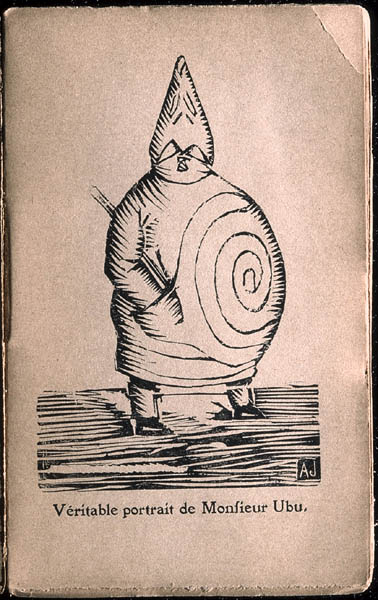
Alfred Jarry, “Véritable portrait de Monsieur Ubu”, woodcut for Ubu Roi, Paris, Éditions du Mercure de France, 1896
It is interesting to note the relation between Ubu’s body architecture, his gestures and the spiral on his robe. The spiral on Ubu’s belly alludes to the qualities of Clinamen – that is, to deviation from a straight line, to deviant movement. It could be the graphic illustration of an atom’s course in the void, an atom that has completed an elliptical orbit and now springs to infinity, deviating from any calculation imaginable.
Ubu, the ambitious major, does not content himself with fate; on the contrary, he follows and asserts his becoming, shaping it in his own way. What matters is how he accomplishes his goals, using base instincts such as passion for crime, an inclination to constant intrigues and all kinds of vices. Can the overgrown Ubu, with his ever-expanding belly highlighted by the spiral design, be a model for nihilist thinkers? Since pleasure is so intrinsically ephemeral, we ‘d better not go without it at all: this could be what Père Ubu has constantly in mind before going on with his next brutal act.
Yet from the point of view of Epicureanism, this is very far from a model of pleasure accompanied by a constant disposition of tranquility, in the sense of the absence of bodily pain and mental anxiety. Thus, one should not confuse real pleasure, as theorized by Epicurus, with the pleasures of the depraved. Within the context of Ancient Greek philosophical schools, Ubu is a Cyrenaic. He is a modern caricature of Aristippus of Cyrene, who taught that the future seems so uncertain that it makes no sense to postpone the moment of a fleeting pleasure. Aristippus reminds us indirectly the logic of Jarry’s hero, through his views that the object of desire and pleasure is irrelevant, and that what matters is just the degree of pleasure and the intensity of the feeling of satisfaction.[iii]
Not only does not Major Ubu, who usurps the throne of the king of Poland, wish tranquility, but he consciously pursues this fleeting pleasure that, for the anti-conformist Jarry, is an ambiguous model / anti-model of himself. In reality, Ubu is the Physics teacher Félix-Frédéric Hébert, in Jarry’s high school in Rennes, whom Jarry used to make fun of, along with his fellow students, in an impromptu marionette theater. The full-bodied professor Hébert incarnates all the negative qualities that young Jarry wanted to criticize, and in the stories of these French teenagers he becomes King Ubu.
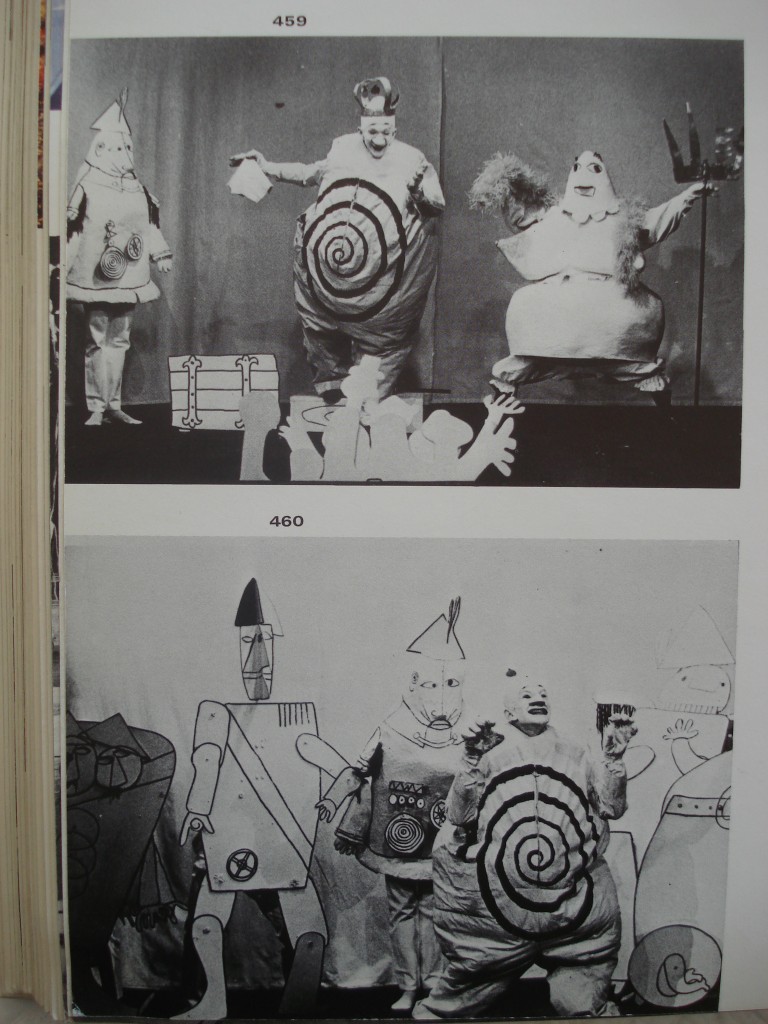
Alfred Jarry’s “Ubu Roi”, stage design by Franciszka Themerson, Dir. by Michael Meschke, Stockholm, Marionetteatern, 1964
Jarry himself refers to the word clinamen, which is the Latin version of Epicurean deviation, in his pataphysical calendar, where it coincides with the month of August. In a less cryptic fashion, the Latin clinamen-deviation is used in Jarry’s 1898 novella Gestes et opinions du docteur Faustroll pataphysicien: Roman néo-scientifique suivi de Spéculations, as a subchapter to describe a painting machine (“Machine à peindre”).
The painting machine is a metaphor of a conscious spatial deviation from a straight line, which “…like a spinning top, it dashed itself against the pillars, swayed and veered in infinitely varied directions, and followed its own whim in blowing onto the walls’ canvas the succession of primary colours…”.[iv] The painting machine, like a “modern deluge of the Universal Seine” is “the unforeseen beast Clinamen ejaculated onto the walls of its universe”.[v] Clinamen, spreading its colors everywhere, could be a metonymic portrait of Jarry, as well as an illustration, in terms of mechanics, of the conditions of the Universe, where atoms are dispersed from a point of departure towards an uncompromised deviation. In Docteur Faustroll, Jarry finds his real model as the inventor of the science of pataphysics, the “science of imaginary solutions”.[vi]
The ornament and the arabesque of Asger Jorn
Although familiar with the literature and the philosophy of Jarry’s discourse, Asger Jorn, who wasn’t a memer of the College but was who was declared ‘Commandeur Exquis of the Ordre de la Grande Gidouille’ wrote in 1961 an article for the Intellectual political movement L’Internationale Situationniste (IS) where he criticized pataphysics for having the qualities of a religion. But his isolated criticism of Jarry’s pataphysics, which was followed by a commendatory note on the part of the publisher, Mr. Guy Debord, cannot possibly annul the influences that nurtured the generation of COBRA (International group of artists and poets, 1948-1951) and the IS.[vii]
An indication of this influence that shows an Epicurean vein in Jorn’s worldview is found in a text entitled “What is an ornament?”(1948), which reveals how close Jorn is to Jarry’s ideas, yet at the same time how much he differentiates himself from them. In this article, he describes “the wave formation matter”, which is the result of the interconnection between the two substances that are active in mutual movement.[viii] The interaction of the different waves through the formalist interpretation can be attributed to the qualities of the arabesque.
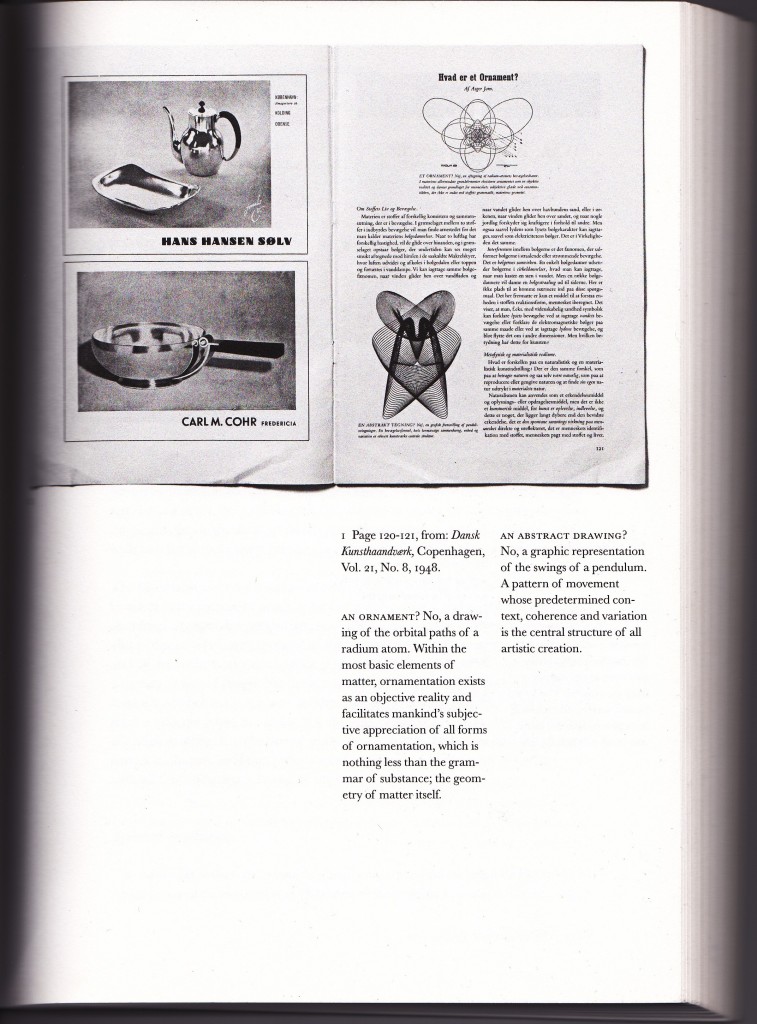
Asger Jorn, page from the essay of Asger Jorn’ ‘What is an Ornament?’ (1948), in Fraternité Avant Tout: Asger Jorn’s Writings on Art and Architecture, 1938-1958, edited by Ruth Baumeister, translated by Paul Larkin (Rotterdam: 010 Publishers, 2011), p.197
From the outset, Jorn gives a summary view of his positions for a “grammar of substance” offered by the philosophy of decoration. More specifically, underneath a picture included in his article, he writes: “An ornament? No, a drawing of the orbital paths of a radium atom”.The physical atom as an ornament and the ornament as a construction that obeys to the laws of physics is an opening to a causality of the deviation of atoms and their reflections towards larger forms, which are destined by nature to move dynamically. The ornament is not programmed to repeat itself unchanged; it changes shape according to the circumstances.
The ingenious Jorn explains colorfully the tendency of matter to result in the organic form of arabesque – similar in this with Lucretius’ clinamen. The shape of the arabesque also comprises Jarry’s gidouille, thus showing immediately an affinity in the treatment of form. Jorn’s descriptions attribute to the arabesques qualities that Epicurus would seek for atoms in the void, spreading everywhere, since anything that moves is destined to take shape, or else to extend linearly as an arabesque in the time-space continuum. At the same time, each arabesque, reacts with other arabesques which have described longer trajectories and “which in turn engage with all that we describe as substances or matter, and of which we only know that there are a myriad arabesque movements – right from the ingenious systems holding atoms and molecules together up to the movement of the planets in space – all circling the solar system’s invisible core”.[ix]
Arabesques can be perceived as the intelligent system of atoms and molecules, and they even explain the movement of plants in space. Accordingly, “we can observe the flowing seas, the evaporation taking place across both land and water, after which it rises to the heavens only to cool once again and condense to rainwater, falling back to the ground so as to join with streams and rivers where the cycle from sea to clouds will start again”.[x] Jorn offers with explicative lyricism the fundamental values of decoration as a life motif. But do arabesques, the quality of movement aside, also have the logic of deviation, as described by Lucretius with regard to the movements of atoms?
Jorn writes: “People rise from their beds in the morning and their pattern of wandering throughout the day describes their own arabesque of footsteps across the earth. They follow the same routes day after day”. And further on: “their footsteps become pathways, which branch out across the terrain and which show where man has left his tracks, and then others go along the same tracks and these become roadways, reflecting the abundance of life – arabesques in man”.[xi] While this description could be attributed to a thinker that sees behind the phenomena visions that repeat themselves identically in time, following a stringent Platonic logic, the answer is finally given by Jorn himself, when he argues that “static forms … have a tendency to become dynamic, because the presentation of dynamic art is the natural way of things”.[xii]
Jorn’s difference compared with Jarry is that the former tries to find a Cartesian acceptance in the dynamic composition of matter, to formalize the Epicurean deviation with the motif of arabesque, although he is no more able to define the limits of this extension. Lucretius expands generously Epicurus’ wisdom, bringing to mind Jorn’s methodology, regarding the traces of arabesques from the small to the grand scale: “Certainly the primary elements did not intentionally and with acute intelligence dispose themselves in their respective positions, nor did they covenant to produce their respective motions; but because through the universe from time everlasting countless numbers of them, buffeted and impelled by blows, have shifted in countless ways, experimentation with every kind of movement and combination has at last resulted in arrangements such as those that created and compose our world…”.[xiii]
Both Jarry and Jorn try to speak, each one in his own terms, about deviation as a fundamental element of free will, which cannot but reflect the Epicurean view of the formation of the Universe. Movements with no connection or movements that deviate from their expected precise recurrence, thus defining what we call contingency, constitute Jarry’s way of philosophizing, through Dr. Faustroll, as well as his nihilistic caricaturizing, through the lame materialist major Ubu.
In the end, if deviation in the sense of declinatio or clinamen corresponds, in terms of social history, to a deviant course, the inclination of which is translated into the subject’s free will, both Jarry, with the blatant destructivity that runs through his writings, and Jorn, with his insistence on an experimental and anarchic creativity, seem to substitute for the claim of an “intelligent design” or the traditional view of God’s omnipotence the subversive qualities of matter. Both expound, though in different ways, a modern-day paganism, compelled by “the presence of a distinct boredom”, going against the supreme will of a god, a doctrine, a predictable existence. Jorn, in particular, advocates“the pure desire for the unexpected, the thirst for surprise… the inclination to difference… the flânerie”.[xiv]
Epicurus’ wisdom is of vital importance for a “deviant” freedom in existential terms. Since all cosmic order springs from this deviation, even the concepts used by the pataphysicians can be moved away from the pragmatist restraint of language, especially if one thinks of Jarry’s exuberant neologisms.[xv] Empirical functions such as a sudden collapse, a violent breakup, a change of course-dislocation, reconstruction or the paradox of love help us, among many others, understand how the Epicurean swerve in physics and philosophy can have an immediate impact on the world of human relations.
[i] Lucretius, On the Nature of Things (De Rerum Natura), translated, with an introduction and notes by Martin Ferguson Smith (Indianapolis & Cambridge: Hackett, 1969), Book II, 216.
[ii] Idid., Book II, 254.
[iii] Despite the similarities between Epicureanism and Cyrenaicism, these two schools constructed very different systems of thought. See Jean Paul Dumont, La philosophie antique (Paris: Presses Universitaires de France, 2003), and W. Windelband-H.Heimsoeth, Handbook of History of Philosophy [Enchiridio Istorias tis Filosofias], Greek translation by Ν. Μ. Skouteropoulos (Athens: ΜΙΕΤ, 1991).
[iv] Gestes et opinions du docteur Faustroll pataphysicien: Roman néo-scientifique suivi de Spéculations (Paris: Charpentier, 1911). I quote here the English edition: Alfred Jarry, Exploits & Opinions of Dr. Faustroll, Pataphysician, trans. by Simon Watson Taylor, Introduction by Roger Shattuck (Boston: Exact Change, 1996), p. 88.
[v] Jarry, Exploits & Opinions of Dr. Faustroll, Pataphysician, op. cit., p. 88-89.
[vi] “Pataphysics … is the science of imaginary solutions, which symbolically attributes the properties of objects, described by their virtuality, to their lineaments”. Ibid., p. 22.
[vii] Asger Jorn, “La pataphysique: Une religion en formation”, Internationale Situationiste 6 (August) 1961, p. 29-32; included in Pataphysics: A Useless Guide, by Andrew Hugill (Cambridge, Mass. & London: The MIT Press, 2012).
[viii] Asger Jorn, “What is an Ornament?” (1948), in Fraternité Avant Tout: Asger Jorn’s Writings on Art and Architecture, 1938-1958, edited by Ruth Baumeister, translated by Paul Larkin (Rotterdam: 010 Publishers, 2011).
[ix] Jorn, “What is an Ornament?”, op. cit., p. 207
[x] Ibid., p. 207.
[xi] Ibid., p. 207.
[xii] Ibid., p. 203.
[xiii] Lucretius, On the Nature of Things, op. cit., Book I, 1008.
[xiv] Asger Jorn, ‘Charme et mécanique, sur le rôle du vandalisme dans l’histoire des arts’, in Asger Jorn “Pour la Forme. Ebauche d’une méthogologie des arts”, Paris, Internatioanle situationniste, 1958. English translation ‘Charms and Mechanisms’, in “Concerning Form”. An outline for a methodology of the arts”, Museum Jorn, Silkeborg, 2012.
[xv] It is interesting to note the deviation searched by Michel Serres in the field of language, when he argues that every language is a unique seed, an original distribution of parasites. He even dares to oppose consonants and vowels in order to convey the necessity of deviation. The ideal example is Ubu’s famous “Merdre” instead of “Merde” at the beginning of the First Act of Jarry’s play. Here is Serres’ argument: “Sometimes winds, breaths, composed together incline toward each other without the intervention of valves or consonants. Oui is a coil, a tress of voice. A bit free, a bit loose, undone, without the anguish of strangulation. Oui without the swarming parasites. Oui in the wind of the Paraclete. Oui in the turbulent tresses of the river. Oui finally works itself loose [se desserre]”. Michel Serres, The Parasite [Le Parasite (Paris: Grasset & Fasquelle, 1980)], trans. by Lawrence R. Schehr (Baltimore, Maryland: The Johns Hopkins University Press, 1982).
AUTHENTIC IRONIES
The text below is an interview that was conducted with Karen Kurczynski in May 2015. Karen Kurczynski is Assistant Professor of Modern and Contemporary Art History at the University of Massachusetts, Amherst, USA and author of the recent publication The Art and Politics of Asger Jorn – The Avant-Garde Won’t Give Up, Ashgate, 2014. A slightly different version of this interview is published in the framework of the Art in Context Programme of the Rietveld Academy, Amsterdam in collaboration with the Cobra Museum for Modern Art. The theme for 2014/2015 was ‘laughter’.
HdB: The Danish experimental artist and thinker Asger Jorn (1914-1973) is well-known for being one of the co-founders of the postwar experimental artists’ group Cobra (1948-1951), and the Situationist International (SI), a movement of artists and intellectuals who strove to achieve social change (1957-1972). Many of those who study Jorn’s oil paintings, etchings, lithographies and other work, will find themselves smiling or even laughing about his puns and parodies, ironic or sometimes tongue-in-cheek humor. In your recent publication The Art and Politics of Asger Jorn: The Avant-Garde Won’t Give Up, Ashgate, 2014, the chapter ‘Authetic Ironies’ discusses the critical and expressive operations of Asger Jorn’s mature paintings, including parody. Here, you identify irony, parody and related strategies as a key element to understanding Jorn’s work, as “foundational to the social nature of Jorn’s aesthetic as a whole …”. Are you aware of previous art historical texts which attribute a similar value to Jorn’s ironizing (including self-ironizing)?
KK: This is an interesting aspect for me to consider now, as I work on an exhibition on Cobra for the NSU Art Museum in Florida (which will end at the Cobra Museum). Because Cobra was not interested in irony at all—or at least, that is what Christian Dotremont writes in one of his key texts, “Par la grande porte” (1949, in a catalog from Colette Allendy Gallery): “They are against ironic painting, which actually tries to express the organic joy of the universe, the historic joy of the world of 1949, but which is ashamed and which trims down the aesthetic impulse […] with an elegant little intellectual penknife.” Jorn too was more interested in authenticity in the Cobra years: he associated irony with the ruling class in his large c. 1947 manuscript “Blade af kunstens bog.” He then explored irony along with humorous strategies more and more over the course of the 1950s. In fact he was always interested in humor in art and in writing, co-authoring a parodic article on a Functionalist named “Everclean” in 1948. Already in his 1952 text Held og hasard, a very Nietzschean text, he rejects the idea of authentic expression. Then by the mid-50s, he openly espouses irony and “lying.” Historiographically, this is precisely the moment his art work begins to be celebrated on an international stage. The critics and curators like Werner Haftmann who wrote about it, however, emphasized it as a return to angst-filled expressionism. Contemporary critics especially in the US, where Jorn’s work is less well known, have continued to dismiss his work as expressionist (or worse, neo-expressionist—ironic and therefore empty) until very recently, after 2000. There are not many art-historical texts that place a high value on irony per se or self-ironizing in Jorn’s work until very recently, when suddenly that issue is becoming ubiquitous. I can’t think of any writer or curator who took his irony seriously until the 21st century, and now I can’t think of any who don’t take it seriously. Those who knew Jorn personally, like John Lefebre and Lawrence Alloway, certainly commented on his humor. It is really the writers you and I know now, our colleagues like Helle Brøns and Axel Heil, who are bringing this aspect into sharper focus today. It’s also related to the evolution of art historiography in general. Jorn (and Cobra) were not taken seriously because their work wasn’t perceived as “serious”—one of the most important key terms in postwar movements like Abstract Expressionism—so writers like Haftmann and Guy Atkins had to present his oeuvre as a serious engagement with major artistic themes. We are in a very different, much more interesting, moment now when artists contribute more writing on art and have helped influenced art critics and historians to recognize the importance of humor and play.
HdB: Irony and parody could be looked upon as a highly self-defensive modes, allowing someone to avert responsibility, to be indirect. However in the title of your chapter the words ‘ironies’ and ‘authentic’ are happily married. This seems to be a contradiction in terms but reading the chapter reveals that you locate the actual criticality and complexity of Jorn’s strategy in the dynamics between both elements. I would be curious to learn more about your perspective on the development of these dynamics. The ‘Authentic Ironies’ chapter discusses parody as a critical operation mostly in relation to work from the end of the 1950s into the 1960’s but (as you also mention) the concepts of irony and artifice are part of the development of Jorn’s aesthetic theory from the Cobra period (1948-1951) onwards. May I ask why you felt it was necessary to make this chronological distinction?
KK: The chronological distinction is really just part of the structure of the book, which focuses each chapter around a theoretical issue (in this case, expressionism and irony) combined with a particular temporal and artistic focus (in this case, Jorn’s mature painting ca. 1957-62). Jorn is interested in humor and play in art from the beginning, from his 30s Miró- and Klee-inspired works onward through Helhesten and Cobra. But I focused on different issues in my accounts of the earlier periods. Also, as I just mentioned, Jorn’s humor and irony come out much more explicitly in his late 50s and early 60s work than at any other period. Each chapter of my book has a title which is a deliberate contradiction, an oxy moron, in a Jornian spirit. It’s the clash of Jorn’s irony in a postwar age so obsessed with authenticity that gives his work such interest, and his position seems newly significant to us now as artists are returning to issues of abstraction and gestural painting but in an extremely sophisticated and sometimes overtly political way, combining abstraction and expressivity with some of the irony associated with pop art, appropriated imagery, and now digital mash-ups—when in the 50s and 60s those two approaches were strictly separated by generation. Recent artists are more interested in combining the best of both generations—the spontaneity and human element in the gesture, but without making it too specialized or spectacular; the humor and sophistication of using appropriated imagery but without it being too easy or celebratory. Jorn’s work does all of this. Today we have a much more sophisticated, “situational” understanding of identity and authenticity in the internet age, and new recognition of the importance of play in the era of video games and “gamification,” that I think makes Jorn’s work seem prescient and newly relevant.
HdB: The following question I have appropriated from a conversation with Jouke Kleerebezem, one of the tutors of the Rietveld Art in Context programme. He was wondering if we could touch upon the type of ambiguity that typifies humor in general, making the ‘laughter’ that results from it an acquired taste, always debatable between those who differ in their sense of humor. So then I wondered if you think Jorn shot himself in the foot every once in a while, and whether he perhaps did not care?
KK: Did Jorn shoot himself in the foot sometimes? Yes. Did he not care? No he did not care. His hits were so on target that I think they excuse a lot of misses that would stand out more in the work of an artist whose work was less complex and multifaceted. He always kept moving which is one of the fascinating things about his work and his artistic practice—it was also a source of heartbreak for those around him, from his wives and girlfriends to his kids, who suffered immensely, and his friends and gallerists. In terms of his humor, take a work like Masculine Resistance at the Museum Jorn, and you can see the retrograde gendered assumptions about the interaction of men and women that make its humor sort of fail from my own feminist perspective today (Helle Brøns has written about the gender confrontation in this work). But at the same time, the failure is itself interesting. It has something to tell us about mainstream gender attitudes in Jorn’s day, on the one hand, and it has a very critical message about the discourses of authenticity and transcendence that characterized art in his day, on the other. Its emphatic vulgarity in both how it was painted and the subject itself is a biting critique and a liberating rejection of the abstract painting that was dominant at the time. So it’s not humor as in a joke, which is always socially divisive (some of the best comics are the most offensive ones—Sarah Silverman for example). It’s more like meta-humor because the humor is always embedded in multiple and contradictory discourses. Jorn’s work is humorous in a way comparable to Richard Prince or Glenn Ligon’s “joke” paintings, which repaint a racist or sexist joke on a monochrome canvas, despite their radically different aesthetics. Whether you laugh at the joke is only part of the point—it makes you stand back and start thinking about what it means to laugh at it in different contexts, as well as (and this is key) the fact that the joke is always so culturally specific that it’s immediately outmoded and, well, no longer funny. So even Jorn at his most sexist or short-sighted has potentially important meanings for us. At the same time, just to negate everything I’ve just said (another Jornian move), I think you can also find passages of sheer physical humor in Jorn’s paintings that might be more universal—the way physical comedy appeals to a wider audience. You can also find references to carnivalesque themes and popular humor as seen in earlier painters like Bruegel and Bosch, and writers like Rabelais who Jorn loved. There are many different forms of humor present in Jorn’s work.
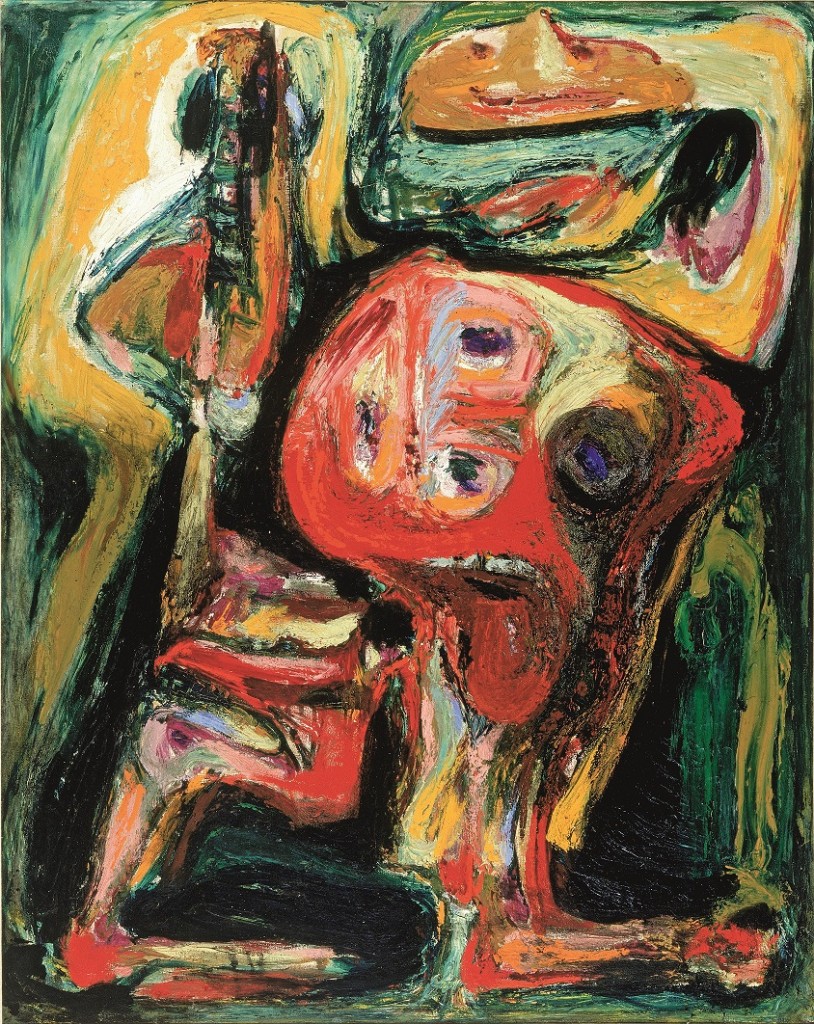
Asger Jorn, ‘Le faux rire (image tragi-comique)’, oil on canvas, 1954. Longterm loan by ABN-AMRO to the Cobra Museum of Modern Art, Amstelveen. Photograph: Henni van Beek
HdB: In 1954 Jorn made an oil painting that literally depicts laughter: Le faux rire (image tragi-comique) which translates as The Fake Laughter (tragic-comic image). At the bottom of the painting we see a (literally) two-faced laughing character in a slightly awkard, half-reclining position while holding something up in the air with one arm. In the background above the laughing character hovers a smaller, friendly looking face. Although the painting is the representation of a fake emotion it funnily enough simulaneously brings across a genuine emotion, the mix of twisted feelings that potentially come with a fake laugh (discomfort? repulsion?). I would like to invite you to closer examine this painting from the perspective of ‘authentic ironies’. In relation to Jorn’s paintings La double Face (The Double Face) and Le Cri (The Scream) you for instance bring up notions such as multiplicity, clichés of the representation of human emotion, the understanding of complexity of the self as a social situation, and Jorn’s insistence on meaning-production as an active process.
KK: This is a great work to bring into focus the complexity and multiple dimensions of laughter we just touched on. The image strikes me as very grotesque in its combination of comic and tragic—humor and angst—in a particularly puzzling combination. The history of the grotesque from ancient times (when it was called the “monstrous”) to the present, as many scholars have demonstrated, typically combines humor with horror. So it relates to a prominent theme in human culture. We can all think of examples of situations that are horrible or harmful that, when considered at a remove, can also be really funny (though at the time it was still largely taboo in Europe to produce humorous imagery relating to the Second World War—Jorn’s work plays with those taboos only indirectly). This image features not just those two dimensions of tragedy and comedy, but also a third, the question of “fake” laughter. The issue of something fake destroys any notion of authenticity and cuts through any attempt to securely define something. Then, Jorn began his painting Stalingrad, le non-lieu, ou le fou rire du courage, the same year—the first title of that painting was “Le fou rire” (Mad Laughter) and it may or may not have been a reference to history or history painting or the “mad laughter of courage” in an epic battle at that point. It acquired the title Stalingrad a bit later. Jorn loved puns and I think it’s likely that he linked le fou rire and le faux rire together deliberately. Fou being a reference to an authentic expression; faux indicating irony and inauthenticity. What strikes me about this image is that it seems more troubling than funny, so is it about laughter at all? Or really, it’s precisely about laughter rather than explicitly funny. It is about the significance of laughter. Laughter and play are elements that rational society suppresses and they indicate a critical distance, a resistance to power. They are also intimately linked to creativity itself and the ideas of play and experiment so prominent in Cobra. Laughter indicates a double perspective. The main figure is not just laughing, but sticking out his tongue, which is a gesture of childishness, defiance, as well as disgust; a gesture referenced earlier in Cobra and examined in Jorn’s later book La langue verte et la cuite. The material fleshiness of the painting is also striking. Parts of figures evoke blood and bones, the mouth and the tongue, the eyes made grotesque as they multiply and roll in all directions. It’s an image of illness (recalling Jorn’s abstract portrait of his injured cousin Mads in the Silent Myth murals) and madness, so strongly linked to creativity. It’s also a visceral painting that affects us in an almost physiological way. As it was made in Italy, this was part of Jorn’s reaction against the sleekness of postwar design culture and his investigation of ceramics at the time. It’s a great example of his interest in Bachelardian ideas of the “material imagination.” It is grotesque because it fails to cohere as a recognizable group of figures. Instead it conveys the process of signification. Maybe it even conveys the process of creating humor itself, and its flipside, tragedy itself, out of the neutral facts of what happens in the world. There is also a recognition implicit here (but signified by the contradictions inherent in the title) that the process of signification is always social. So what one calls greatness, another calls tragedy, and yet another calls humor.
PILLAR HUGGERS – A WORKSHOP AND EXHIBITION AT OR GALLERY, BERLIN
with Antonis Pittas, Johann Arens, Jay Tan, Klaus Weber, Christoph Keller, Hilde de Bruijn, Shannon Bool, Hadley+Maxwell
January 23 – April 18, 2015
Reception Friday, January 23, 7:30PM
Curated by Hilde de Bruijn, Shannon Bool and Hadley+Maxwell
The Danish experimental artist and thinker Asger Jorn (1914-1973), well-known as one of the driving forces of Cobra (1948-1951) and L’Internationale Situationniste (1957-1972) was a fierce collaborator, always looking for international exchange and discussions, facilitating collective work, magazines, and exhibitions. With great drive and ambition Jorn also wrote numerous books and articles envisioning, from an artistic point of view, ‘the first complete revision of the existing philosophical system’. Jorn believed that art is not derived from an ideology or worldview, but is the direct expression of an attitude towards life, belonging to the fundamental level of work and production. In line with this, Jorn combined in his writings ideas from a wide range of disciplines including politics, physics, economics, philosophy, anthropology, structuralism and art theory. He brought these various interests together via unconventional methods and in a vast variety of forms, in search of a comprehensive theory of art and life.
The architectural figure of the pillar-hugger as it appears in Jorn’s 12th Century Stone Sculptures of Scania1 represents a character whose body has become petrified while attempting to tear down a Cathedral by its vertical supports. A small group of artists have been invited to occupy the position of Pillar Huggers for a one-day visual symposium at Or Gallery Berlin where their work will form the material of their conversation. Transposing Jorn’s definition of a materialist attitude toward making art (as he articulates in the essay ‘What is Ornament’ (1948)) to exhibition-making, the artists are asked to animate the position of the body who, through its transformation into the inorganic, becomes the support for the very same edifice it attempts to destroy. How can we reconcile the compulsion to ornament with a resistance to the compulsion to make an exhibition? Can we avoid the exhibition as monumental decoration by approaching the encounter of and between artwork with the spirit of Jorn’s conception of vandalism and the spontaneous arabesque?
The remnants of the workshop opened to the public at 7:30 pm on January 23, 2015, and have also resulted in the visual essay What is Jornament? (published on this blog). The text is taken from the book Fraternité Avant Tout – Asger Jorn’s writings on art and architecture, 1938-1958. Editor: Ruth Baumeister. Translator: Paul Larkin.
Publisher: 010 Publishers.
—————
[1] The book traces the infiltration of a non-Christian iconography of pillar-huggers, beard-pullers, and double-heads in the decorative programs of churches built in the aftermath of pagan Scania by the recently converted kingdom of Denmark around the year 1000.
About the artists:
Klaus Weber is an artist, who lives and works in Berlin, he has shown extensively in both Europe and the United Sates. He conceives works across a variety of media and spatial units, which are often based on multifaceted technological interconnections and intricately organized production processes. Yet, by purposely manipulating everyday structures, the tracing of deviations and the exploration of the impossible, they undermine the metaphorical and actual power of a functionalist rationality. In doing this, Weber repetitively uses images of nature, and explores the sustainable potential of the untamable in a humorous and anarchic manner. Weber has had institutional solo shows at the Fondazione Morra Greco in Naples, the Nottingham Contemporary, the Secession in Vienna, the Hayward Gallery in London, as well as the Kunstverein in Hamburg. The artist has participated in group shows at the MOCA, Los Angeles, the Mori Museum in Tokyo and at the KW Institute for Contemporary Art, Berlin. Weber is represented by Andrew Kreps Gallery in NY and Herald St Gallery in London.
Shannon Bool (1972, Canada) originally from Vancouver Island, she attended Emily Carr University before studying in New York, Frankfurt and moving to Berlin were she lives and works. Solo exhibitions include: The Fourth Wall Through the Third Eye, Galerie Kadel Willborn, Düsseldorf; Walk Like an Etruscan, Daniel Faria Gallery, Toronto (2013); The Inverted Harem II, Bonner Kunstverein (2011); CRAC Alsace, Altkirch, France; The Inverted Harem, GAK-Gesellschaft für Aktuelle Kunst, Bremen (2010); RMIT Project Space, Melbourne, Australia (2008). Group exhibitions include MMK2 Boom She Boom, Works from the MMK Collection, Frankfurt; The Klöntal Triennale, Kunsthaus Glarus, Switzerland (2014); Soft Pictures, Fondazione Sandretto Re Rebaugengo, Turin; Painting Forever!, KW, Berlin; Justina M. Barnicke Gallery, Toronto (2013); the Sprengel Museum, Hannover (2012); 7×14, Kunsthalle Baden-Baden; Tactical Support, Gallery Tracy Williams, New York; Rock Opera, CACP Museum of Contemporary Art, Bordeaux (2009); Drawing on Sculpture: Graphic Interventions on the Photographic Surface, Henry Moore Institute, Leeds (2007); Make Your Move, Projects Arts Centre, Dublin; Spiralen der Erinnerung, Kunstverein in Hamburg; Carbonic Anhydride, Galerie Max Hetzler, Berlin (2006). Work is held in the collections of Berlinische Galerie Landesmuseum Fur Moderne Kunst, Fotografie und Architektur, Berlin; MMK Museum fur Modern Kunst, Frankfurt am Main; Lenbachhaus, Munich, and the Saatchi Collection, London. She is represented by Kadel Willborn Gallery in Düsseldorf and Daniel Faria Gallery, Toronto.
Johann Arens (born in Aachen, Germany 1981). He uses installation and video to survey the documentary properties of public interiors. By systematically re-editing the hardware of a location he draws up an abstract inventory of the social textures inherent in the site. His work is an enquiry into the role of human interfaces, the desire to touch artefacts and the mechanisms of user behaviour. After graduating from the Gerrit Rietveld Academy in Amsterdam, he received a stipend by the Netherlands Foundation of Visual Arts to complete his MFA in Fine Arts at Goldsmith, University of London. Since then he has worked on public commissions assigned by Arnolfini / Art and the Public Realm, Bristol, Letchworth Heritage Foundation and Jerwood Foundation London. In 2013 he has been awarded the Rome Fellowship in Contemporary Art by the British Academy and has recently started his residency at the Rijksakademie in Amsterdam.
Recent solo shows include ‘Internet Centre & Habesha Grocery’, Paradise Row, London; ‘Apple and Pear’, ASC Gallery, London; ‘Effect Rating’ De Service Garage, Amsterdam. Recent group shows include ‘New Contemporaries’, ICA London; ‘No Soul For Sale’ Festival, Tate Modern, London; ‘A useful-looking useless object’,Sierra Metro, Edinburgh; ‘I’ll explain you everythiinnngggg’, Chert, Berlin; ‘Hard Copy’, Pastificio Cerere, Rome, 2014 and ‘TTTT’, Jerwood Space, London.
Antonis Pittas (1973, Greece, lives and works in Amsterdam). As an artist, he mainly creates context-sensitive spatial installations, which are in formed by architecture, art-historical references, the performative aspects of installation art, and its social dynamics. Recent solo exhibitions, include: montage at Annet Gelink Gallery, Amsterdam, 2014, Performing Silence De Nederlandsche Bank (DNB), 2013, Amsterdam, Retroactive at the Hessel Museum of Art & CCS Galleries Bard College, NY, 2011/2012, Landart at the Benaki Museum, Athens, 2012, Untitled (this is a historic opportunity for us), at the Van Abbemuseum in Eindhoven, 2010, Next to his art practice, for the last seven years Pittas has been a teacher at the Rietveld Academie in Amsterdam, in 2014 semester professor in university of Hildesheim in Hildesheim as well as a guest teacher in many academy’s in Europe and U.S, Antonis Pittas is represented by Annet Gelink Gallery, Amsterdam
Jay Tan (1982, Croydon, UK, lives and works in Amsterdam) often uses hobbyist approaches and materials in her sculptures, installations and performances, to produce works in which tactility and basic mechanics perform key roles. We are participants in complex choreographies (histories, politics) where the most measurable properties and forces of the material world produce, fold into, collide with and emerge from our laws, languages and loves. Jay graduated from the Master of Fine Art Programme at the Piet Zwart Institute, Rotterdam in 2010. She has recently participated in group shows at Holly Bush Gardens, London, Karst Gallery, Plymouth, Camden Art Centre, London and PLAYTIME, the Rennes Biennale. Solo presentations include “The Work is Spun…”Rongwrong, Amsterdam, “The Retired Engineer” at the Witte de With Centre For Contemporary Art, Rotterdam and “You Can Stand and Watch Or Spar” Trapéz Gallery, Budapest. She is currently a resident at the Rijksakademie van Beelende Kunst, Amsterdam
Hilde de Bruijn (1971, NL, lives and works in Amsterdam) is a freelance curator and a curator at the Cobra Museum of Modern Art, Amstelveen. Her main freelance activity at the moment is a curatorial research into the writing and thinking of Asger Jorn (1914-1973) which builds a starting point to re-think issues in contemporary artistic and discursive practices – see also www.hildegoesasger.org. She is the co-editor of ‘ Archive Crisis’ , an artists´ book by Stefanos Tsivopoulos, designe Node and to be published by Japsam Books in Autumn 2015. Between 2007 and 2010 she was Head of Exhibitions at SMART Project Space, Amsterdam. She was an advisor for the NL Film Fund, the Mondriaan Foundation and City of Utrecht.
Hadley+Maxwell (artists duo since 1997, Canada, live and work in Berlin). Hadley+Maxwell’s installations, performances and writings, employ diverse media to rework iconic images and traditional forms as they are expressed in pop-cultural, artistic and political movements. They cut into reified narratives via direct touch, transposition and refiguration, putting into play the absences cast in relief.
Hadley+Maxwell have been collaborating since they met in Vancouver, Canada, in 1997. Public presentations of their work have included solo exhibitions at Artspeak (Vancouver), Contemporary Art Gallery (Vancouver), Künstlerhaus Bethanien (Berlin), Kunstverein Göttingen (Germany), Smart Project Space (Amsterdam), and Project Art Centre, Dublin, and group exhibitions at galleries and festivals including the Vancouver Art Gallery, Kunstraum München, the Power Plant (Toronto), the National Gallery of Canada, Taipei Fine Arts Museum, the Seattle Art Museum, La Kunsthalle Mulhouse (France), Witte de With (Rotterdam), the 4th Marrakech Biennale and the 19th Biennale of Sydney. They are represented by Jessica Bradley, Toronto, and live and work in Berlin, Germany.
Christoph Keller, born 1967 in Freiburg/Breisgau, studied Mathematics, Physics and Hydrology in Freiburg, Berlin and Santiago de Chile, at the University of Arts, Berlin and at the Academy of Media Arts, Cologne. Selected solo exhibitions and projects include: Small Survey on Nothingness, Schering Stiftung, Berlin (July 5 – October 4, 2014);Expedition Bus – Shaman Travel, Presentation at abc Berlin (2012); Aether between cosmology and consciousness, Nouveau Festival Du Centre Pompidou, Paris (2011); Voyages Extraordinaires, CRAC Alsace Lorraine, Altkirch (2010), Observatorium, Kunstverein Braunschweig (2008).Recent group exhibitions include: Realität und Fiktion, Villa Schöningen, Potsdam (2013); Ghostbusters – or how to stress photography, Kunsthal Charlottenborg, Copenhagen (2013); Virtuosity – A concert on skill and disruption, strength and nonchalance, morale and cheating, Berliner Philharmonie, Berlin (2013); L’Institut des archives sauvages, Villa Arson, Nice (2012) and The Worldly House, Archive for dOCUMENTA (13) (2012).
The exhibition at Or Gallery took place in collaboration with the Embassy of Canada.
WHAT IS JORNAMENT?
What is Jornament? is a visual essay created by artists Shannon Bool, Hadley+Maxwell and Jay Tan making use of enlarged copies of the English translation of Asger Jorn’s text ‘What is an Ornament?’ from 1948. The text is taken from the book “Fraternité Avant Tout – Asger Jorn’s writings on art and architecture, 1938-1958.” Editor: Ruth Baumeister. Translator: Paul Larkin. Publisher:010 Publishers.
SISSV: AN EXPERIMENTAL APPROACH TO THE ARCHIVE OF THE SCANDINAVIAN INSTITUTE OF COMPARATIVE VANDALISM
The entry below is an email exchange that took place after a workshop in the framework of hildegoesasger at Officin (Copenhagen) where Niels Henriksen presented his research on Asger Jorn’s Scandinavian Institute of Comparative Vandalism (SISV) and Ellef Prestsæter together with Nicolas Malevé presented the work in progress of the Scandinavian Institute of Contemporary Comparative Vandalism (SISSV), an experimental art/research project engaging with the archive of the SISV at the Museum Jorn.
Niels Henriksen is a Ph.D. candidate in the Department of Art and Archaeology at Princeton University, USA. He is currently preparing a thesis on the adaptation of archaeological concepts and procedures in Asger Jorn’s book projects and paintings from 1948 to 1965.
Ellef Prestsæter is an independent researcher, artist, and curator. He is a founding member of the SISSV, together with Michael Murtaugh and Nicolas Malevé. He works at the University of Oslo and writes regularly on art and literature for Klassekampen, Vinduet and Kunstkritikk. Most recent publication: The Invention of the Bright Day by José de Almada Negreiros, translated from the Portuguese into Norwegian and Reports from the Gutenberg Galaxy (http://www.obs-osv.com/gutenberg).
Asger Jorn founded the Scandinavian Institute of Comparative Vandalism (SISV) in 1961, shortly after leaving the Situationist International. Jorn published a series of theoretical “reports of the SISV” and planned the production of some thirty volumes of coffee table books devoted to 10,000 Years of Nordic Folk Art. Eventually only a pilot volume on 12th Century Scanian Stone Sculpture was published. An archive consisting of more than 25,000 negatives taken by Gérard Franceschi and Ulrik Ross (commissioned by Jorn) bears testimony to the magnitude of the endeavor.
NH: My first question regards your framing of your intervention this summer with the SISV in terms of a sort of manual for operating the archive. I am interested in the structures you identified in the original archive, and how you chose to engage with them.
EP: When we started working with the SISV archive at Museum Jorn in Silkeborg, the first thing we needed to do was to develop an understanding of how the archive works, to map the relations, conjunctions and affordances[i] of the archival apparatus. There are more than 25,000 negatives in the filing cabinet. They are all ordered according to geographical location. The corresponding contact sheets as well as enlargements are indexed with a code unique to each image. Thus this image of a wooden stool, to take a random example, is indexed as N7-2-29. N indicates Norway, 7 means that the image was shot in the county of Oppland, 2 gives the further geographical specification of the Gudbrandsdalen valley and 29 is the number given to this specific image.
The key to all of this is a document we refer to as the “white binder”. The binder was produced in the 80s by Stephanie Nørgaard, who was given the task of cleaning up the archive and has been an invaluable source of information for us. Interestingly, she told us that in order to crack the code of the index, she would start with Jorn’s published books (where some of the photos were reproduced) and work her way backwards to the photo archive, reverse-engineering the image articulations of the book, so to say … The white binder maps the overall structure of the repository very well. However, it does not encompass all the material remains of the SISV. Working with the images, Jorn would select the images he wanted to use for some purpose and put them in boxes. Later he would order the images in a particular sequence by putting them into albums that served as mockups for the planned books. A large number of images have been preserved in both “states” of ordering: there are more than 50 boxes and a number of albums. The boxes and albums are not stored in the filing cabinet (indeed they are usually stored in a different part of the museum building; our exhibition at the Museum Jorn this summer brought them into proximity with each other as we moved everything into one room). The boxes and albums bear witness to different stages of Jorn’s work with the images, or so it would seem. Each box and album contains a typewritten sheet where someone (Stephanie says it wasn’t her) has duly indexed its contents, adding a brief annotation of the depicted object. N7-2-29 for instance, appears in an album indexed as Modern times. Volume 6. The common people’s art of wooden images and wooden architecture and has been given the following annotation: “Lillehammer Folk Museum, Norway. A stool with three legs, made of a piece of wood resembling a snake. ?+” The question marks multiply in these annotations.
Most of the boxes are indexed with speculations as to what volume of the 10,000 years of Nordic Folk Art series Jorn had in mind for the selection. The word “possibly” occurs very often: “Hunters’ art. Possibly Antiquity volume 1”. The indexing remains hypothetical, a series of speculations. For us there is something attractive about being able to archive according to hypothetical connections (this is typically what you would want to avoid when setting up a relational database). At the same time, these annotations can be seen as problematic in the sense that they have been made with the book project as sole interpretative grid, with the presupposition that all the orderings can be explained with reference to that project.
This raises the tricky question of whether the SISV can be reduced to the Nordic book project only. This is a widespread assumption, held by, for instance by the art historian and former director of Museum Jorn Troels Andersen, who has engaged deeply with the archive over the years and even published six volumes based on Jorn’s maquettes. But what then, do we make of all the images from Spain, France and Italy? Are they not related to the SISV? In addition, the filing cabinet contains 39 albums with images sorted according to motifs. They include images from the SISV repository as well as from other sources (museums etc.) and date from around 1970 (they were taken to the archive from Jorn’s house in Colombes after his death). These images are by no means restricted to the Nordic sphere. Are these orderings unrelated to the SISV project?
NH: I wonder if you think it is possible to conceive of Jorn’s conceptualization of the archive in relation to his proposed publication series of 10.000 Years of Nordic Folk Art in terms of an apparatus and a manual? What would that imply?
EP: Your questions suggest an intriguing reversal: the image articulations based on the photographic repository preceding it somehow working its way into the latter’s structure, reordering it as its operative manual. Interestingly, such a movement, where a particular use of an archive would feed back into it and transform it is exactly what this archive cannot accommodate. It is significant that whereas you can always trace an image back from one of the boxes or albums to the “archive proper” (the filing cabinet) by means of the code written on the back of most prints, it does not work in the other direction. Looking up an image in the filing cabinet will not point you in the direction of its previous use, whether it has been selected for one of the boxes/albums or appeared in books etc. A book such as the one on the stone sculptures of Scania can only work its way back into the archive as a new document, given a unique location in the archive (indeed there is a folder in cabinet 7.4 containing most of the images selected for the book as well as documents specifying their sequence in the book).
On another level, the sequences and selections developed by Jorn do serve as suggestions as to how the images in the repository might be handled. As such they are perhaps better described as examples rather than manuals in the strict sense. Jorn explicitly made clear that his orderings were not definitive or exhaustive. In one of the texts you translated for October magazine, he states that “the publication of the series “10,000 Years of Nordic Folk Art” should be a historic event in itself, in the most proper sense of the term, meaning a temporally limited phenomenon that could soon be replaced by another series, composed in a different way” (Structuralism and suppression, 1967). Also, and even more interestingly (not least for the SISSV!), he ended the 1965 annual report of the SISV (where he announced the temporary closure of the institute) by claiming that the book series “never had been of central importance to the SISV, whose material is primarily meant for other purposes”. In part this may be seen a rhetorical move in the light of the book project’s failure, but I believe there is more to it.
To reiterate, I don’t see the work of the SISSV in terms of creating an operative manual to the archive. Understanding how the original apparatus works was rather the starting point for experimenting with new ways of operating the archive, this time with digital tools. If the strength and weakness of the analogue archive is the rigidity of its structure, a digital archive can perhaps let different orders co-exist in a more flexible and dynamic the way. New articulations can work their way back into the archive and become new structures.
Digitization brings about an archive whose holdings are no longer only addressable at the level of the individual image but also as pixels, histograms, “significant features” or contours detected by different software. All this enables the relationship between parts and wholes to be played out in completely new ways. Here you will find a quick guide, a preliminary manual of sorts, to some of these experiments. I believe our approach can be described as playful, multifarious and experimental, pretty much in the spirit Jorn outlined in a letter to the British anthropologist Francis Huxley in 1969:
“My method is systematically in-konsequent and non-cronologic without other determinations and conclusions except the choice of subject and what eventualli comes out of the puzzle. Some peaces comes to fit together and make groups of relations and perhaps more general visions comes out of it, or perhaps not. So my questions have only the scope to force you to break up my combinations if you see that they are wrong, and put them together in another way if you see a combination, or if you have some pieces to join. It is a game. You don’t know exactly what comes out.“ How would you see the relationship between apparatus and manual? I would be interested in hearing more about your understanding of Jorn’s concept of history as related to a kind of “operative vandalism”.
NH: I very much enjoyed reading about your research on the historiography of the SISV archive. What I wanted to propose by the terminology of apparatus and manual was the idea, which you seem to share, that the archive might have been conceived as a device facilitating other projects and uses than “10.000 Years of Nordic Folk Art.” On the one hand, the failure to preserve the key for the cataloging system, which in any case seems provisional, indicates a lack of interest in the potential for outside use. On the other hand, the deficiency of the cataloging system imposes the necessity on each inroad into the archive of defining an order anew. Thus, each sequence composed from the archive becomes a model for the understanding of the entire repository.
It is for the same reason that I like your shift to the term repository. Because it reflects how this archive—rather than preserving of an abstract system—commands the continuous re-creation of meaning and order with each new approach. This mechanism of continuous re-ordering also implies a superimposition or even eradication of previous attempts, which, to me, gives an indication of what Jorn might have meant by “comparative vandalism.”
Finally, I wonder whether the setup of the archive and its use, as I have proposed to understand it, might also apply to the kind of ‘reader’ experience that Jorn envisioned for the recipients of “10.000 Years of Nordic Folk Art.” On the dust jacket of 12th Century Scanian Stone Sculpture Jorn quotes five different ordering systems, one of which is described as “more or less coincidental.” Thus, the extent of the visual sequences counting hundreds of images, and the inconsistency of their ordering, emulate the characteristics of the main archive repository, only on a smaller scale. This, of course, speaks against the notion of a steadfast division of apparatus and manual, since the “readers” would have to define their own conceptual frameworks, just like the potential users of the larger archive. The idea of an apparatus and a manual is, however, still appealing to me, if for no other reason then because of its implication of active involvement.
EP: I am curious to know how you see the relationship between the image repository and the book series on the one hand, and the paperback reports of the SISV on the other. The connections are by no means obvious! In short, how should we understand the relationship between the material technologies of memory (negatives, paper, inventory, archive etc.) and the theoretical, historical and speculative “superstructure” of the SISV as an engagement with the past?
NH: If you look at Jorn’s “Postscript” in 12th Century Scanian Stone Sculpture, which was published as a pilot for the proposed “10,000 Years of Nordic Folk Art” book series, Jorn frames his project as an archaeology as opposed to a history. He defines archaeology—by contrast to history’s tracing of “actions and events”—as the development of “the most ordinary types” in a stratigraphic overview of “…the homogeneity and variation of repetitions.” In addition to archaeology, Jorn defines his project within a terminology of vandalism, adapted from the literature on the destruction of art. Vandalism denotes the research focus on graffiti, heathen iconography in Christian churches, and folk art, but also Jorn’s “archaeological” approach to that object field. Thus, the definition of vandalism does not distinguish between visual production and interpretation. In that, Jorn’s vandalism reminds me of the Situationist strategy of détournement, described by Tom McDonough as borrowing in equal part from Bertolt Brecht’s Umfunktionieren and Lautreamont’s plagiarism.
The notion of a logic of appropriation posed between deliberate critical re-inscription and anarchic attack on the integrity of authorship and singularity of events, I think, also applies to Jorn’s concept of vandalism. Both détournement and vandalism are based on the idea that the construction of the present relies on the simultaneous creation and destruction of the past. I think of the sequence of 12th Century Scanian Stone Sculpture as a reflection of Jorn’s interest in the inherent destructiveness of history writing, or archaeological excavation for that matter. The excessive repetition of similar motifs in the sequence overreach all pedagogical utility and seem more in the vein of Lautreamont than Brecht. My interpretation of Jorn’s vandalism may seem to some to be too generous in its assessment of the criticality of his project. At the same time as Jorn’s vandalism is full of vestiges from his involvement with the Situationist International, the rhetoric of a specifically Nordic or Scandinavian vandalism or barbarianism suggests the notion of a recourse to a primal origin that dates back to the Cobra years, and which is contradictory to the vandalist archaeology as I have just outlined it.
Further reading:
Asger Jorn: “Postscript to 12th Century Stone Sculpture of Scania” [1965]. October 141 (summer 2012), pp. 73-79. Translated from the Danish by Niels Henriksen.
Asger Jorn: “Structuralism and Suppression” [1967]. October 141 (summer 2012), pp. 81-85. Translated from the Danish by Niels Henriksen.
Niels Henriksen: “Vandalist Revival: Asger Jorn’s Archaeology”. In Asger Jorn: Restless Rebel, eds. Dorthe Aagesen og Helle Brøns (Statens Museum for kunst, 2014), pp. 226-237.
A book about the SISSV project, with essays by Teresa Østergaard Pedersen, Matthew Fuller and Éric Alliez, is forthcoming in 2015.
[i] An affordance is often taken as a relation between an object or an environment and an organism, that affords the opportunity for that organism to perform an action.
ASGER JORN: THE SECRET OF ART
The text below is also part of the publications Asger Jorn: the Form and Beyond, edited by Luca Bochicchio and Paola Valenti, Genova University Press, Italy, November 2014, and Asger Jorn: The Secret of Art, Cobra Museum of Modern Art, Amstelveen, The Netherlands, 2014 (limited edition, designed by Richard Niessen).
The public sessions in the framework of hildegoesasger.org at the Athens Biennial 2013 and at Casco, office for art design and theory in Utrecht early 2014, built the basis for this text.
After having worked exclusively with contemporary art for about ten years, I started a job as a curator at the Cobra Museum of Modern Art in the winter of 2011. This called for refreshing my knowledge of Cobra, the loose constellation of young left-oriented artists and poets that officially existed from 1948-1951. The energetic Danish experimental artist and thinker Asger Jorn (1914-1973), well-known as a painter and a co-founder of Cobra and one of its driving forces, attracted my special interest. He was always on the move looking for international exchange and discussions, creating collaborative work, magazines, and exhibitions. What I have learned since 2010 is that Jorn, with great thrive and ambition, also wrote numerous books and articles envisioning, from an artistic point of view, ‘the first complete revision of the existing philosophical system’.
In his writings Jorn combined ideas from a wide variety of disciplines including politics, physics, economics, philosophy, anthropology, structuralism and art theory. The way he brought these various interests together in complex and unconventional ideas and ways, in search of a comprehensive theory of art and life, appeals to me for various reasons; especially his strong ideas on art as not derived from an ideology or worldview, but as the direct expression of an attitude towards life, belonging to the fundamental level of work and production. Jorn’s views result in a very outspoken position in the philosophical debate about the value of art and the position of the artist in society. In this perspective, art historian Graham Birtwistle makes the crucial observation that: “(…) in placing [art] at the basis and not in the superstructure, Jorn’s theory gives to art both a primary role and a certain independence from conventional ideological idealism.”[1]
Over the past years (and currently) the value of art and the position of the artist in society has been a much discussed topic in several European countries. Politicians announced budget cuts and other vigorous measures for the cultural sector in the light of the (ongoing) credit crisis. I wondered if the questions that Jorn posed and the position he took could still be relevant for the analysis of our current situation. Could Jorn’s theory, and more important his (art) practice, give us “certain independence”, as mentioned by Birtwistle, with our society transforming at a rapid pace from ‘market economy’ to ‘market society’?
After reading an essay by the Belgian sociologist Pascal Gielen I realized that Jorn, who had strong political views and anti-capitalist ideas, might have shared Gielen’s perspective on the current situation in Western society as one of ‘repressive liberalism’.[2] He defines repressive liberalism as a situation in which the state embraces ‘freedom’ and the ‘free market’, whereas the control of that freedom has in fact increased. The result is an extremely conditional form of freedom, or freedom as an instrument of control. Within this, Gielen says we are facing a situation of political dialectics replaced by a bureaucratic middle class that aspires to a measurable and controllable mediocrity.[3] Indeed a contemporary echo of Jorn’s words:
“For an elite to have real power it must have rights and regulations other than the rest of the population, it must form an extraordinary order. As this monopoly is abolished in modern democratic society, the administrative posts can only be occupied by the best amongst the mediocre, chosen from the good citizens. The disorderly and the extraordinary, the poor and the best are excluded automatically … .”[4]
Gielen also states that in fact, the past ten years the jargon of liberalism has been embraced with surprising and quite uncritical easiness, using politically charged language (including terms such as culture consumer, entrepreneurship, marketing) as if it were neutral, as if it were devoid of an ideological signature. He points out that anyone who nowadays opposes the rhetoric of repressive liberalism is labelled a naive romanticist. Isn’t this perhaps one of the major problems with what Jorn has to offer us as well? That it is hopelessly romantic? What could be distilled or taken from Jorn’s way of thinking to practise a genuinely critical art towards culture in our times?
The spice of life
Not surprisingly, Jorn never showed any hesitance in advocating and claiming an essential role for the arts in life and society. He wrote:
“What we are talking about here is art and its justification, its meaning and its place in our lives and society. Art does not exist simply for the enjoyment of beauty, nor to point a moral finger. Aesthetics and ethics are nothing more than playthings for philosophers and theologians. Art is a life and death issue; a human necessity. What I am referring to here is the creative, artistic urge and its sets its stamp on all our actions (…). There are core life values which can only grow in freedom, and only when truly free can they form a central part of the way we lead our lives.”[5] He even goes as far as to claim that: “There is a widespread misconception that one’s daily bread takes precedence over the spice of life and that we must all have practical homes before we can even start thinking about putting up frivolous buildings.”[6]
With the above statement Jorn wasn’t simply trying to advocate freedom for the arts for the sake of the arts. In all his texts he kept on expressing in various ways that this freedom was essential to be able to experiment and consequently essential to the generating of new knowledge. According to Jorn, this made it crucial for human society and the human race to develop further. In order to do so artists would need, what he called “free or unused energy”, which he identified as a potential scarcity in a (capitalist) society that claims all available energy. Almost cheekily, Jorn added that strictly speaking, the arts are not necessary. It only is if one desires progress. And if so, one of Jorn’s prerequisites to opening up the possibilities for an effective utilisation of the artistic possibilities would be “that society can afford, and is at liberty, to give architects and artists a free hand in the creation of the best environment for mankind.”[7]
The give-and-take between artist and society was of great concern to Jorn, as this citation also shows. In “Value and Economy …” he reflects on the topic at length and states that artists (and other cultural producers) are in fact exploited by the power elite and that “Art and culture retain only a minimal part of the sums that they earn”[8] as artists and other makers are not paid for their hours of productive work. He builds up his arguments in great detail but it might be most effective to present his example: “If the Americans just paid according to the tariff for the time they occupy themselves with European culture, then the whole of Europe could live off it.”[9] It would be obvious to conclude that Jorn simply argued that from now on artists and other makers should be paid for their hours of productive work[10] (especially as he also stated that the aim of his text “Value and Economy …” is to demonstrate the economic basis that ‘the creative elite’ is entitled to), but he loved undermining and contradicting, and his arguments often had an unexpected twist. In this case he ends the very same paragraph by saying that if what he suggests would be realized, it would have the (I take it as undesirable) effect of “stagnation of our artistic culture”.
Jorn obviously was well aware of the fact that art has a lot to do with economics, at the same time though he often pointed to those aspects that can’t be measured in money:
“Art is a life form. It is mankind’s celebration (and maledictions on) all aspects of life that enliven us. Architecture is the framework upon which we build our lives but the arts are the living framework around life itself. Artistic creation is the spiritual and psychological sea in which we swim and which provides life-giving nourishment.“ [11]
It is in social interaction and spiritual immeasurable values that we can find what Jorn calls “the secret of art”:
“The secret of art consists in the simple fact that it is more blessed to give than to take, but also that this blessedness is dependent upon voluntary giving, so that what is given is felt as a surplus, a wealth, not a duty. This is the simple materialistic explanation of the value of the art work and for all other things called spiritual values. In relation to the practical values, art is thus a counter-value, the value of productive pleasure. Art is the goal for a discharge of energy without a precise goal, except the one that the receiver can discover. In this way, art is the source of benevolence, is what is called grace.”[12]
Holistic as this may sound, the artistic strategies that Jorn applied make him the exemplary model for the recalcitrant modernist artist to whose strategies contemporary artists – “problem solvers of social problems on a micro level (…)” – should return, according to Pascal Gielen. No safety, order and comfort, no self-management disguised as cultural entrepreneurship for the sake of calculability and controllability,[13] but the creation of problems and “creative destruction” is what Gielen calls for. It is true: “Asger Jorn loved difficulties. If there were none, he created them, for himself and others”, writes Wieland Schmied.[14] Risk was also an extremely important element in Jorn’s thinking and strategies, and certainly not a factor that he wanted to reduce to acceptable proportions, in the ‘entrepreneurial’ sense. “(…) I have never been interested in going anywhere unless I was able to go all the way to the extreme”[15], Jorn said. Gielen’s call for creative destruction bears strong similarities to Jorn’s fascination for vandalism as a potential creative act, and his (and those involved in the Situationist International) well-known strategy of ‘détournement’ – basically the adaptation of or variation on previous ideas or works, in which the newly created has a meaning that differs from the original one.
These and other artistic strategies worked very well for Jorn and the other people he was associated with, but as stated in the preface of Collectivism after modernism, recently reborn collectivism has little or none of the leftovers from its own rich past.[16] Rather than looking into specific artistic strategies that worked well for artists in the Cold War era (and which might or might not work well here and now), I suggest that we take two elemental questions to heart. The first question is whether we can find the inner conviction that art is an elemental need (and if we have the willpower, or are prepared, to put this idea into practice).[17] The second one has to do with the idea “that artisthood is not an individual fate (…) but can rest on a collective foundation of solidarity structures”,[18] as Gielen phrases it so rightly.
Perhaps this is a good moment to remember the lifelong stipend that Jorn passed on to the Belgian poet Christian Dotremont, and to bring up Jorn’s donation of over 1,500 art works by various artists to the city of Silkeborg (today at Museum Jorn). Or the donation of his premises in Albisola, Italy, to the community, on the condition that his artist-friend Alberto Gambetta could continue living there until his death and that it would become a public venue after that. These examples not only testify to what looks like solidarity (or generosity) in various of Jorn’s actions. They also point to Jorn’s “second prerequisite to an effective utilisation of the artistic possibilities”: the artistic prerequisite,[19] to which collaboration between artists is a pre-given.
To Jorn collaboration and ‘brotherhood’ were vital and primary artistic solutions. Within these collaborations he regarded disciplinary boundaries of no importance, he rather advocated their abolition. He also rejected the idea of making compromises – so that everyone involved in the collaboration can give his best. The artists involved would share, what Jorn calls “the language of the new age”.[20] He wrote:
“It is the change-over to another rhythm of life in which the essential thing is not the emphasis on the private, the masterpiece, the individual, … not the division of life into closed-off forms, rubrics and classifications, but life’s own rhythm, luxuriance and free growth …,”[21] or: “it is not just a matter of creating an organic, living and cohesive architectural style, but also of creating a living lifestyle, an organic collaboration between human beings – an organic society in effect.”[22]
What is important to add is that to Asger Jorn, the idea of an ‘organic collaboration’ (or any other idea for that matter) takes the subjective, irrational side of human nature into account. To answer one of my initial questions: I can only agree with Jorn that this ‘romantic’ approach is in fact truly realistic.
Let us return to the second question: How to practise a genuinely critical art towards contemporary culture today? Perhaps it is not too far fetched to claim that in our individualistic society, focused on specialization and demarcation, collectivism by its very nature is genuinely critical (towards the art world’s system of individuality in particular). In her essay ‘Internationaleries – Collectivism, the Grotesque, and Cold War Functionalism’ Jelena Stojanović writes about influential European collectives which were all, with the exception of one, co-founded by Jorn: Cobra, International Lettriste, Mouvement pour un Bauhaus Imaginiste, and the Situationist International. She points out that they:
“took upon themselves the immense and utopian task of reimagining collective subjectivity. That is, of redefining the very notion of utopia for the cold war era, a time when the “colonization of everydayness” first took on an unconditional presence. They sought to achieve this gargantuan task by employing what they believed was the only available tactic: a critical art practice, informed by the cold war in which negation, debasement, and blasphemy were discharged against all highly promoted cultural values including “art”, but also the “avant-garde”.”[23]
Perhaps the second question to take from Jorn and his co-conspirators is whether we are up to reimagining collective subjectivity in a time of repressive liberalism.
[1] Graham Birtwistle, Living Art – Asger Jorn’s comprehensive theory of art between Helhesten and Cobra (1946-1949), Reflex, Utrecht 1986, p. 55.
[2] Pascal Gielen, “Repressief liberalisme – Over kunst, markt en cultuurbeleid in Nederland”/“Repressive Liberalism: The Dutch Cultural Policy System” (summary in English), Kunstlicht (no 1/2, 2013). Translations are my own and I refer to the Dutch text.
[3] Dito, p. 14.
[4] Asger Jorn, “Value and Economy – Critique of political economy and The exploitation of the unique”, published in French in 1959 by the Situationist International. In 1962 Jorn published “Value and Economy …” as Report no. 2 of the Scandinavian Institute of Comparative Vandalism. I refer to Peter Shield’s English translation in The Natural Order and other texts, Ashgate, London 2002, p. 203.
[5] Asger Jorn, ‘Architecture is not art’, 1943 translated by Paul Larkin in: Ed. Ruth Baumeister, Fraternité Avant Tout – Asger Jorn’s writings on art and architecture, 1938-1958, 010 Publishers, Rotterdam 2011, p. 53.
[6] Dito. Jorn’s words were not empty rhetoric, he and his family lived in very poor conditions for a long time. He was seriously undernourished by 1951, indicated as one of the reasons for him to get tuberculosis, and when he moved to Albisola, Italy with his family they lived in a tent along the riverside for a while.
[7] The painter Asger Jørgensen, ‘Notes on the Way’, 1945, in Baumeister, p. 82.
[8] “Value and Economy …”, p. 190.
[9] Dito.
[10] He literally meant that if I would amuse myself for one hour with a piece of art, a boxing match, chess game and so on, I would owe the maker/entertainer one hour of productive work.
[11] Asger Jorn, “Face to Face”, 1944, in Baumeister, p. 66 and 67.
[12] “Value and Economy …”, p. 184.
[13] Gielen, p. 14.
[14] Wieland Schmied, ‘The Graphic Artist Asger Jorn’, in Asger Jorn: The Secret of Art, Cobra Museum for Modern Art, Amstelveen 2014, p. 37.
[15] Asger Jorn, ‘Against Functionalism’, 1957 in Baumeister, p. 278.
[16] Ed. Blake Stimson & Gregory Sholette, Collectivism after modernism: the art of social imagination after 1945, University of Minnesota, Minneapolis/London 2007, p. xii.
[17] In line with this and Jorn’s concept of “a living art” Gielen mentions the need for artists who are capable of translating their strategies into “actual life forms” (werkelijke levensvormen).
[18] Gielen, p. 18.
[19] Asger Jorn, ‘Notes on the Way’ in Baumeister, p. 82.
[20] Dito, p. 83.
[21] Asger Jorn, ‘Formsprakets Livsinnehåll’ (The lifecontent of the language of form), Byggmåstaren, Stockholm, XXVI, 17, 1947, in Birtwistle, p. 317.
[22] Asger Jorn, ‘What is an ornament?’, 1948 in Baumeister, p. 206.
[23] Stimson & Sholette, p. 38.
ASGER JORN: PRODUCTION, CONSUMPTION, ADMINISTRATION
The chapter ‘Production, Consumption, Administration’ by Asger Jorn is part of the larger text “Sauvagerie, Barbarie et Civilation” which appeared in French in Signes gravés sur les églises de l ‘Eure et du Calvados: Asger Jorn, P-V. Glob, Gutorm Gjessing, Michel de Bouard [et al.], Collection: Bibliothèque d’Alexandrie v. 2, ed. Asger Jorn, published by the Scandinavian Institute of Comparative Vandalism, 1964.
English translation for www.hildegoesasger.org by Chad A. Córdova, 2014
PRODUCTION, CONSUMPTION, ADMINISTRATION
Consumption is self-production.
Among the antagonisms peculiar to economic structures, the most important, it seems, arises vis-à-vis the problem of locating causality in the relations between production and consumption. That is, do we create in order to consume, or consume in order to create? Which of the two activities is a function of the other? and, with this mystery solved, will we better know the agency [instance[1]] hiding behind administrative power, or, further, to what this agency itself is subordinate?
Earlier, we indicated that the events of economic reality arrange themselves in series that vary broadly depending on the zones of European culture — there are three of them — in which these events take place.
For Nordic minds, the importance of the link they establish between the past and the present distracts them from any purely current event or expression. If, exceptionally, they would like to concentrate their attention on such an event, they would be unable to keep themselves from bringing to bear on it everything from the past that, in their eyes, appears relevant — on the understanding that the most distant past will also be required to provide information.
Destruction and death — the end — are traditionally seen as passages towards the past. The problem with this attitude is that one can say that every complete process, in any domain whatsoever, always presents itself as a destruction of the given conditions. Moreover, destruction can take place without any benefit to superior creativity. The right to destroy is hence the sign of superiority. By refusing the peoples of the so-called barbarian invasions[2] any justification for the destruction they wrought, one remains faithful to the ancient hierarchical structure of the Roman Empire, a system by now totally bankrupt.
DESTRUCTION – CONSUMPTION
Viewed from without, each act of consumption presents itself under the guise of destruction.
In today’s economy, the instability of the production-consumption equilibrium is only apparent. We have here a false notion, which masks both the importance and the volume of production and consumption.
In actual fact, the considerable augmentation of the means of production, on the one hand, and of the needs of consumption, on the other, tends to create an absolute correspondence and equivalence between the two.
Indeed, we are moving towards perfect equilibrium.
Among the facts on the basis of which production “conceives of its products” is the conviction that consumption is essentially of a destructive nature. No creation of objects is undertaken without the addition of elements that will precipitate their consumption. Factors of destruction, these elements accelerate the objects’ demise.
Today, the life of the manufactured product is thus intentionally shortened from the outset. It is no longer durable, but ephemeral. Its consumption is no longer deferred, but immediate. Solidity and stability are no longer desired, and the Americans have even invented an expression to refer to these products guaranteed to not last long.
Considering this situation, vandalism seems to us to be simply a type of consumption like any other.
Just so, certain economists see war and wartime economy as one gigantic consumption. Essayists and philosophers assure us that production necessarily leads, in the more or less long term, to a wartime economy.
THE APPLICATION OF SITUGRAPHY IN EUROPE
Triolectic analysis alone is capable of dissipating the confusion generated by effects that, so far, have remained unrecognized. Thus the importance of methods for locating fundamental complementarities. How can these be detected?
We will take as irrefutable evidence that complementarity exists between two cultures the fact that, in one of them, the forces of Reaction[3] wield — with the intention of reining in progress — the progressive ideas of the other culture. Today in Europe we are witnessing precisely this sort of situation. One need only look to the North, to the South, to the East.
Geographically, the geometric layout of the capitals of the Latin countries[4] reflects a composition at once median, symmetrical and central. All roads lead to Rome; or to Paris; or to Brasilia.
Stockholm, Oslo, Copenhagen, London, New York: border cities turned, in reality, toward the unknown, and open to the foreigner [à l’étranger].
Like prewar Vienna, Berlin bore the traces of the character of the old Holy Roman Empire[5] created by Charlemagne. Exploiting Berlin’s status as border city was a constant of American postwar politics. The agreement [entente] with Russia will obviously displace the locus of this interplay [jeu] to Jerusalem — the border city of the “Christian nation.” The conflict between Abelard and Bernard is topical once again, but this time the answers are known in advance. Fascination is no longer possible, except for imbeciles.
At the core of any system or social organization, three complementary elements can always be located: production, administration, and consumption. The Latin, Germanic, and Russo-Byzantine systems differ according to each system’s unique method of applying these elements. The Latin system appears to be characterized, first, by the virtualization of administration and, second, by the actualization of the unity of production and consumption, a unity in which the proportion of the two components varies. The Germanic system is characterized by the virtualization of consumption, on the one hand, and, on the other, by the actualization of a fusion between production and administration. Finally, the Russo-Byzantine system is based upon the virtualization of production and the actualized fusion of administration and consumption.
Earlier, we pointed out the existence of a parallelism by which consumption resembles destruction. For the Germanic peoples[6] — and for them alone — the act of consumption is infused with and animated by the will to purity to such a degree that this will makes their system of consumption unique. On the other hand, the Latin principles of consumption permit, authorize, and promote a certain freedom of play, and do so without further restricting the same freedom of play in the sphere of production. But within the Latin framework, freedom of consumption — or of destruction — never becomes absolute, and remains always short of the “barbaric point” of the Nordic peoples.[7]
These different systems, which are responsible for different types of “mises en situation,”[8] led the Situationist movement to recognize and accept the diversity of these methods. It is because this movement deigned to examine their different natures in a critical fashion, that it was able to maintain its own homogeneity.
In the first years after the war, opposition to the traditional concept of art appeared under one of two forms. Some declared themselves in favor of a new sort of art, whose domain would stand in opposition to art understood according to its traditional concept [art classique]. Others were more radical still: they decided to deny the value of art in every domain by means of an anti-artistic mindset. In Latin culture, both the opposition to art and art’s marginalization were, of course, never absolute — this opposition being above all rhetorical. But it must be emphasized that this essentially rhetorical opposition, and which hence sets aside any personally adopted attitude as well as all sincerity, is of a terribly more radical nature than all other oppositions. Thus, in Paris, we witnessed this modern mindset — armed with the explicit intention of withdrawing all possibilities for freedom and development from art, and with the secret intention of transforming it into a means or instrument —, create a situation that strove for the complete annihilation of art as it had been known before [qui tend au vide complet].
This crisis of art, which we are experiencing today, finds its most extreme illustration in the conflict of the S.I. Deeply representative of the Nordic existential attitude in the artistic domain, this movement would gain in originality and authority if the ideas of the different minds that, in different capacities — philosophers, poets or thinkers — fall within Existentialism, were more familiar, and if the public had better knowledge of how these different ideas are interrelated. Thus, behind Kierkegaard hides Poul Martin Möller, a bit like how we find the genius of Socrates behind Plato’s system. Let us say in passing that there is no way one can believe that Socrates — originally a sculptor — would have consented to the exclusion of the liberal arts later professed by Plato.
Sartre committed the gross error of considering Kierkegaard’s scholastic system to be a humanism. Shortly before his death, Poul Martin Möller wrote a poem entitled “The artist among the rebels.” This poem recounts how, in 1830, a group of rebels in Paris entered into the studio of an artist with the intention of destroying his work, and how the attacked artist vigorously reacted with a violent counterattack. This poem, which served as grounds for its author to be classified as “politically reactionary,” must have made a profound impression on me. Remarkable for its great beauty, the poem is just as remarkable for its political character. Half a century after the imaginary clash it depicts, a similar conflict, only real this time, broke out during the Paris Commune. This poem seems, again rather prophetically, to have highlighted the contradictions that today have become internal to the S.I. as a result of how the movement’s unity has been put into question by Debord and all his followers.
The anecdote of the arsonists who, during the final days of the Commune, went to destroy Notre-Dame and encountered a battalion of armed artists, “constitutes a good example of direct democracy” and allows us to grasp, in terms of a specific instance, the ambivalence inherent in any act of protection that is a priori conservative. That is, against these men who wanted to accede to expression by translating their total defiance of a society of oppressors into a destructive manifestation, was the ensemble of artists right to unanimously defend Notre-Dame in the name of permanent aesthetic values? and ultimately, in the name of the spirit of Museums?
Partisans, politically speaking, of the Commune, “these artists acting as specialists found themselves in conflict with a radical expression of the struggle against alienation.” (Debord), Aux poubelles de l’histoire.
What happens when, at the end of a confrontation, one of the protagonists disappears? and, in particular, when, of the three elements involved, precisely the one that stood alone against the group of the other two is annihilated? Between the remaining two sides, whose union against the common adversary once formed an actualized antagonism, a schism is immediately produced. Depolarization polarizes the prior allies. A struggle arises for the possession of the goods, now up for grabs, of the vanquished adversary. The appropriation of these goods will set off in their future possessor a process of identification with the prior adversary; in other words, a new union representing a possibility for actualization. Every war and every confrontation strives to annihilate an adversary who is, at bottom, less real than virtual. This means that the demise of the latter in some ways actualizes its reality, and to such a degree that, at the end of the confrontation, we sometimes have the paradoxical impression that the loser is the winner. It goes without saying that, were the two surviving protagonists to lack the will to appropriate the goods of the now absent adversary, no combat would take place between them.
Debord no doubt betrays his mentality and Latin political pedigree by considering artists to be sheer specialists and, ultimately, mere instrumental means.[9] History shows that artists have always struggled against the apriorism of this notion. Their participation in all great revolutionary movements bears witness to this fact, and they have always considered this sort of utilitarian attitude towards art to be a form of oppression and an assault on their freedom. This oppression was adopted, made official, and legalized in 787 by the Second Council of Nicaea.
By approving the arsonists’ actions against the armed artists,[10] Debord fell into the trap Estivals had set. For years the latter has never tired of repeating that the affinity linking us together, Debord and I, is “something totally practical, without any basis in shared ideas.” Unfortunately, in this particular situation, in which a socialism and a barbarism confront one another, by lending his assent to arsonist vandalism, Debord is surely on the side of the barbarians. For — let us ask ourselves — by what means did those artists imagine they would destroy the arsonists? Quite simply: by recourse to Teutonic acts…
In a society in which military reality is all-powerful, seeking to determine the degree of barbarism in actions and behaviors is a vain undertaking destined for failure. Accepting vandalism implies, ipso facto, consenting to Teutonism [teutonism]. That Debord — engaged [engagé[11]] as he is today — could return to the conventional and accepted positions, which are in fact those of the Parisian avant-garde, seems to us to be neither desirable nor possible.
The concept of situation — this jack of all trades [concept à tout faire] of Existentialist thought, this pseudo open-sesame of an obsolete and misbegotten philosophy — did not get J.-P. Sartre very far. The vitality of Situationism lends a rather moribund appearance to Franco-German Existentialism, with its resting comfortably on an ensemble of old propositions — precisely those belonging to Danish Existentialism of the past century. Oblivious to its own derivative character, the French offshoot of Existentialism did not, however, entice Debord. Nonetheless, we have become the amused onlookers to a paradoxical spectacle: on the one side we have Sartre, who at first concerned himself with writing for future generations, was gradually forced into the contemporary, and then drowned in an excessive currentness. On the other side there is Debord, interested only in what is topical, who finds himself condemned to erect a distant future, and this in view of a posthumous glory to which, in fact, he is indifferent…
The Latin mind and the Latin character adapt themselves easily — naturally — to the existentialist credo, “live in the present.” For them the pure instant is an obvious truism, an immediate reality, while for Nordic thought and temperament — let us say, for Kierkegaard — the pure instant is a demented dream and a vain hope.
Fear that Cobra’s activity might lead to a unilateral Nordism led me to seek out the collaboration of a man in whom I saw, as a fertile promoter of new ideas, a possible ideal successor to André Breton. This man was Debord; and nothing since has made me change my mind about him.
STATE — FAMILY — NATION
In his study of the origin of the family, Friedrich Engels develops Marxist thought on the factors of human progress. To him this “progress” appears to pass through three phases: the savage stage — which is that of pure consumption, and corresponds to the non-productivity of hunters; the barbaric stage — characterized by production oriented towards consumption; and the civilized stage — which, producing simply in order to produce (outside of all consumption), is linked to the emergence of slavery. The slave was a producer to whom any and all right to consumption was denied. In forms deceitful and masked, Western society has created types of subjugation and servitude that in no way differ from ancient slavery.
All false judgments, errors, and illusions concerning the notion of progress are ruthlessly exposed by the triolectic system. It is impossible to create a valid opposition to barbarism without seeing savagery and slavery as one and the same thing, which, in essence, is civilization. Civilization is savagery justified by the moral obligation to maintain slavery. It is at once a material consequence and a social reality: production that leads to no consumption. To isolate the producer, to free the slave: these are the real ways to stand up to Barbarism, to Savagery. They comprise the program and goals of Socialism — a way of thinking that betrays the intention to “make peace” with the Savage, in order to recuperate for Civilization the force that animates him as a destructive force. Thus does socialism ingloriously resort to the tired opposition between civilization and barbarism. It attempts to draw production and administration closer together, and refuses to see that the union of the two represents nothing more than a new antagonism: an inexorable process, which is hell for all, and from which the Situationist International alone has freed itself.
Today we know that — as an expression of the will to social progress — each revolution engenders a superior social life, yet introduces into this very same life a greater degree of uniformity under the guise of stability, and ruthlessly restricts the freedom of all. The Situationist mindset is committed to trying to recover the rights to free human play, play aimed at reducing “alienation” [“Entfremdung”].
Graffiti — whether they are Norman, Parisian, or from somewhere else — are evidence of a desire for presence, and of an opposition to sacrosanct technique. An orientation such as Situationism runs the risk of seeming counterrevolutionary. In fact, such a movement allows us to clearly see the error committed by the engineer Sorel, who studied the revolutionary movements of this century in accordance with his tabula rasa system. At the start of the last century, Poul Martin Möller already sensed the possibility for error inherent in the following apothegm: A revolutionary movement is of value only during the stage preceding its practical realization. This formula can be taken in different ways, and can give rise to notions deriving from a mechanist reality. For example, one could understand it to mean that only during a downfall are energies, new and readily available, liberated; that after the downfall there comes about a new stage in which the energies become more obstructed than they were before. In this way, even the triolectic system is at once a springboard and an impediment: it frees up energies, then it blocks them from being used. Poul Martin Möller recognized this long ago: “A new idea is of value only while it is being absorbed into the masses. Once it is generally accepted, it loses its value.” It is hence obvious that on the day the oppositions dividing Europe into North and South disappear, exceptional sources of an admirable energy will, by the same token, also disappear. It is not merely a duty, it is a right to demand that this energy not be wasted on vain struggles, and that it contribute instead to general enrichment.
Among the histories of the Germanic peoples, Friedrich Engels’ seems to me to be the most intelligent and the most impartial.
To the question: “What was the mysterious magic charm thanks to which the Germanic peoples breathed new vital force into a Europe in agony?”, Engels provides an excellent response, without, however, completely explaining why the mere emergence of barbarism in a civilization was enough to create new sociological foundations — foundations both superior and enduring.
Engels tells us that: “The Germanic peoples were barbarians insofar as they were incapable of instituting complete slavery[12] in the sense that labor slavery in Antiquity and domestic slavery in the Orient were complete.” In the depths of the psyche, rights and duties are undifferentiated from one another. The notion of property as “fruit of personal labor” — the notion at stake here —, is thus invalid when applied to that sphere.
Engels continues: “Civilization engenders a class that is not occupied with production (nor with consumption), but only with the exchange of products: merchants.” Engels does not seem to see that, once liberated from the merchant class out of which it arose, this activity then shaped structures of the State. Thus it is with a certain frivolity that Engels states: “The gentilic organization ceased to exist and was replaced by the State”, and: “with the division of society into classes, the State inevitably falls; it is relegated to the museum of antiquities, next to the spinning wheel and the bronze axe.” In that case, it can be expected that the spinning wheel and the bronze axe will always remain indispensable instruments.
“Conjugal union is the cellular form of civilized society. It marks a stage of great historical progress. Nevertheless, with conjugal union an epoch begins in which each step of progress is also — at the same time — a corresponding step backwards.” Engels is here speaking of an epoch in which physicists discover the law of conservation of energy. This law is of no import in the socialist world, for in the eyes of the Marxists — as well as in Lassalle’s — : “Collective power is greater than the sum of the individual powers taken separately.”[13] We here enter into the miraculous…
Engels wondered how it was possible that the Roman family, organized in a more primitive manner than the gens (people-family), could represent a degree of progress vis-à-vis the latter. He wondered, too, how the barbarian gens of the Germanic peoples could represent the same sort of progress with respect to the Roman family. It seems that the underlying reasons for this evolutionary dynamic escaped Engels entirely.
The barbarian gens was by no means eradicated. Indeed, it was so little destroyed that its original vigor has, over the centuries, been progressively transformed into real power. As a result, today the barbarian gens alone can be opposed to the concept of the State. Only, it is no longer called the gens, but the nation.
The identification of past with present, of origin with reality, of emergence with contemporaneity, lends life to the reputedly noble notion of nation. If — rightly acknowledging the important Germanic part played in the making of medieval Europe — we nevertheless deny this Germanic element a role in modern culture, we run the risk of understanding absolutely nothing about Europe’s future. It will remain shrouded in darkness.
The Europe of the gens became the Europe of nations thanks to the Arian Church. The significant role played by this church in the evolution of Europe would seem to us even more essential if we had at our disposal all the information of which a long and intentional obscurantism continues to deprive us. The transformation of gens into nation was greatly facilitated — if not completely brought about — by the theologians who, in the form of the baptismal ceremony, introduced a ritual whose great symbolic power [pouvoir de signification] provided a salutary shock for all consciences. The ceremony of Christian baptism symbolically defined a new era: the dawn of a renaissance.
We can readily understand the importance that this ceremony had in Scandinavia; and this even before the rise of Christianity. We can also understand why, still today, Scandinavians display an obsessive interest in medieval baptismal fonts. It would not be easy to explain the participation of the Nordic peoples in the Crusades if one were to deny them all feeling of religious belonging to the Christian nation.
France was the only European country not to have been duped by the national character of Christianity’s expansion. In The Birth of the Middle Ages, L.B. Moss explains why: “In Gaul, Clovis crowned his great work with the organization of a national church, which combined the political advantages of Arianism and Catholicism.” The symmetry of roles played by the State and the Nation would later drive the French to become the standard-bearers of the idea of nationalism, and then — without tripping too much on the stumbling block of chauvinism — to enrich the world with a notion whose effects are still palpable: the notion of internationalism.
Thus it is that, defenseless against the Catholic “church-state,” the Christian nationalism of the Germanic peoples found itself subjected to theocratic pressure exerted by this terrible “church-state,” which itself, moreover, was incapable of bearing the secular responsibilities of a theocracy. This theocratic pressure cast into the flames the last of the Nordic hopes, which went up in the smoke from the same stakes at which the Templars lost their lives. To France is due this pitiful glory; yet the nation-state had been created. In this new State, there was room for the family and for its majordomo [chef-majordomus] who, unfortunately, would become known as chancellor.
Women who, in the North, were both occupied with and in charge of the house, would see their importance grow enormously due to this expansion of the family and increase in its importance. We are familiar with the effects of this process thanks to the history of the Middle Ages: playing the Church and men off each other, women later became the prisoners of both. Things took a different course in Byzantium, where the State was triumphant. The Soviet Republics are both nations unto themselves and united in an all-powerful State. At least this is the case of the Russia that Stalin portrayed in his book on nationalities.
It is more than interesting — it is impressive — to compare the creation of a union among socialist Soviet republics to the genesis of a nation like the United States, where the idea of nation has an expansive form that goes beyond the scale of the state.
It is necessary to have some understanding of the complementarity that exists between French internationalism, American nationalism, and Russian statism, if one would like to avoid becoming the victim of chimera and illusions concerning possibilities for arriving at an understanding among these countries [entente générale].
TING[14] — POLIS — SOVIET
The modern State differentiated power into three forms: legislative, judicial, and executive. By uniting two of these powers — as we are told by the principle of antagonisms —, the modern State was able to acquire both vitality and dynamism.
For the Latins, virtualization is virtualization of judgment; for the Nordic peoples, on the other hand, it is virtualization of execution. We must, I believe, emphasize this point: for the former, fusion takes place between legislation and judgment; for the latter, fusion occurs between legislation and execution. Since it is a given that legislative action is political in nature, the dynamism of the polis here finds itself concretized. In the Nordic ting, execution is unconditional, and it is judgment that assumes a political character. We see that the principle of the ting, far from being a “rudimentary polis” as it is often said to be (especially in Germany), possesses a dynamism uniquely its own, and which is complementary to that of the polis.
The superior judicial bases of political power in the U.S.A. have lent to the ting-principle’s application there a certain purity unknown to its application in Scandinavia. The killing of the man presumed guilty of Kennedy’s murder exposes occult political maneuvers, which are an infringement of the very governmental system the United States chose for itself at the end of the Civil War. Will the solemnity of that act ever be sanctioned?
The hesitations of those who descend from the old Nordists [anciens Nordistes] to legally take advantage of this matter proves the existence of an underlying affective complex of dispositions [complexe passionnel de tendances]. The killing of Kennedy’s presumed murderer seems to present a similarity, both odd and charged with meaning, to an episode from the struggle of the Germanic peoples against the Romans (the episode recounted by Engels): the maneuver that Arminius used to beat Varus, thereby putting a definitive end to the Romans’ plans for colonizing the Germanic countries. Confronted with actions, principles, and methods radically alien to them, the Romans were forced to realize their powerlessness and to abandon their enterprise. In both cases we witness civilized values suffer the same defeat at the hands of violence and brutality.
During the War, there was a man in Holland who found the Danes’ and Norwegians’ curiosity for the invaders so sickening that he decided to take his own life. If this honorable man had known the story of Arminius, perhaps he would have been less shocked by the fact that no one turned their back on the invaders, and he would have doubtless sensed that this attitude would make of the Scandinavian resistance the most effective of European organizations.
Arminius remained by Varus’ side exactly as if he had been his friend, all the while organizing and setting in place the enormous enterprise that would crush the Roman army. If he had so desired, Arminius could have even driven the Romans out of Gaul. But he was not a conqueror. It was William the Bastard[15] who first brought this possibility to light.
From this episode dates the tenacious and intransigent mistrust of the Romans for the Germanic peoples.
It would seem that, in these circumstances, the Germanic peoples had been obeying the following precept: “One must only be honest to honest people,” a rule of the ting. Regarding the way the Romans judged the event, Engels tells us that “it is as if we were reading French writers from the most chauvinist of eras, who pour their chalice of anger out over Yorck’s breach of faith and the Saxons’ betrayal at the Battle of Leipzig. The Germanic peoples had become familiar enough with the loyalty of the Romans and their fidelity to treaties when, during negotiations and in a time of armistice, Caesar attacked the Usipetes and Tencteri by surprise; or when Augustus had the legates of the Sicambri thrown in prison, having, before the legates’ arrival, refused any and all negotiation with the Germanic tribes. All conquering peoples have this in common: they trick their adversary in every way possible, and find this behavior absolutely in order. But as soon as their adversaries permit themselves to do the same, they cry perjury and treason. However, the means used to reduce to submission must be considered equally lawful [licites] when used to throw off the yoke.”
The accuracy of this last consideration of Engels’ is irrefutable. We should nonetheless note that the Germanic peoples applied themselves to refining and making remarkably effective two techniques unique to them: the technique of disorganization and the technique of protest. In the latter they achieved such a high degree of effectiveness that they were called — quite correctly — the Protestants.[16]
We must understand the importance that the ting-principle has come to have in American life, and how much it permeates the very spirit of that country’s laws. An obligation such as that under which is placed every citizen appearing before a judge to tell “the truth, the whole truth, and nothing but the truth” is significant in this respect. We have before us the honest man of the ting. He who refuses to yield or dissimulates information is, on the other hand, dishonored and excluded. Whether or not information is intimate in character does not impact the obligation of absolute honesty.
This practice is rather hard to reconcile with the ideal of the polis; an ideal whose rhetoric, quite to the contrary, obliges one to “say everything but the truth,” and which, among many other stories, that of the young Spartan illustrates. His intestines ripped apart by a fox, he prefers to die rather than admit he is guilty of theft. Each of the two methods has its advantages. But the American desire to use them conjointly leads to disastrous impasses.
In Northern Europe, acknowledgment of deeds was always made in the form of vague and imprecise confessions. When these deeds were very circumstantial, the account would become ambiguous, obscure, and nebulous to the point that one no longer understood anything. This was the beginning of an anti-rhetoric that, later, suffused a certain type of literature. This literature was exasperating for a purist of an eminently critical mind such as Anatole France, who saw it as defiant of that renowned clarity the French value so much.
Thus the Germanic mind seemed inclined to dissimulation. Strabo depicts the Germanic peoples as “devious; a people made for lying,” and the Roman Velleius speaks of the Celts in these words: “Simple-minded people lacking in wickedness; under the gaze of all, they carelessly rush into combat; hence their adversaries always achieve an easy victory.”
But a critical sense, taste for precision, and attention to exactitude often bred in the French both a need for truth and its intoxication that, ultimately, go by only one name: cynicism. For frankness—linked, by etymology, to “the Franks”—can also produce despicable certitudes.
Nonetheless, France is indeed the worthy successor of that fiery Gaul. France has to her credit a taste for political justice that confers her with the status of being the best guarantor of equality and truth in the world.
Of the various contributions of the provinces to France’s vitality, the Norman factor has not been among the least important.
And, as for art, Norman graffiti contributes a great deal to elucidating the meaning [signification] of the image, the sign, and writing.
The appearance of soviets, or people’s councils, was not foreseen during the Russian Revolution, though the soviets were in fact its driving force. Lenin did not see in them the reemergence of that old tradition of Slavic culture. He believed they were a creative miracle of the people. Polis, ting, soviet: three complementary modes of structuring [structurations] that are irreducible and fundamental to the development of Europe. Along with Aron, the psychologist C. G. Jung based his explanation of the unconscious on the polis’ type of spiritual structuring; Adler opted for the ting’s, and Freud for the soviet’s — and without any of these modes of structuring being of a “political” order.
Even on a modernized classical basis, it is impossible to entertain even the illusion of synthesis here. A new method is necessary. Will this be the triolectic method? We shall see.
[1] Instance. The term “instance” cannot be deployed without evoking Freud — and, today, Lacan. In order to not let this possible reference slip between the lines, I’ve rendered “instance” as it is translated in English versions of Freud’s works (the German word is “Instanz”). — Translator’s note.
[2] La grande migration. Since “the Great Migration” has come to mean the movement of African Americans out of the rural Southern USA (1910-1970), the term “barbarian invasions” (Völkerwanderung) is used. — Translator’s note.
[3] La Réaction. Jorn occasionally capitalizes nominal forms that, elsewhere, he might not (e.g. Reaction, State, Socialism, Barbarism, Savagery, etc.). I’ve left these words capitalized in the text. —Translator’s note.
[4] Pays latins. The adjective “latin” and its nominal form “les Latins,” used by Jorn throughout, will be translated as “Latin” and “the Latins” respectively, with the word “Latin” employed “as a designation for the European peoples which speak languages descended from Latin” (OED). — Translator’s note.
[5] Empire romano-chrétien. Jorn’s term mistakenly refers not to Charlemagne’s empire, but to the Roman empire following the reign of Constantine I (the Christian Roman Empire). I have rectified this error in the text. — Translator’s note.
[6] Les Germains. Throughout this translation, “les Germains” is translated as “the Germanic peoples.” — Translator’s note.
[7] Les Nordiques. Throughout this translation, “les Nordiques” is translated as “the Nordic peoples.” — Translator’s note.
[8] Mises en situation. “Mise en situation” evokes both the realm of cinema, where it can mean “staging” (e.g. of a scene, a scenario), but also the domain of business and education, in which it means “role-play scenario” or “simulation.” Since none of these meanings seems preferable over the others — and since the concept of situation is clearly important in this text —, I’ve left “mises en situation” in the original French. Though variously nuanced, all its possible meanings evoke the placing persons (or agents) into a particular situation, which can be more or less fictional; a sort of actualization of roles or functions, as it were. — Translator’s note.
[9] True, Debord opposes this specialization. But does he not proceed all too hastily in making specialization a necessary characteristic of all art, thereby totally dissolving the problem of art tout court?
[10] Although no. 10 of the Situationist theses on the Paris Commune — the theses, that is, that professor Henri Lefebvre of Strasbourg University pillaged in his recent book — is limited to identifying, without trying to solve, a problem — namely, that of the legitimacy of certain antagonist actions in the context of the direct democracy of an armed population —, it would not be pushing things too far to observe that the sympathy of the authors is clearly on the side of the arsonists of Notre-Dame.
[11] Engagé. Jorn appears to conscientiously use this adjective so associated with J.-P. Sartre’s position on the political role that befits art. Hence I’ve rendered “engagé” as “engaged,” instead of the perhaps more felicitous choice — to English ears, at least — of “committed,” so as to evoke the association with Sartrean philosophy. Moreover, while “committed literature” is not rare, “engaged literature” seems to be a more common translation for Sartre’s famous notion, “la littérature engagée.” — Translator’s note.
[12] Esclavage total. I have translated “esclavage total” as “complete slavery” in order to accord with the English translation of the Engels text to which Jorn is here, and below, making reference. See Friedrich Engels, The Origin of the Family, Private Property and the State (Chicago: Kerr & Co., 1902), p.189. — Translator’s note.
[13] See Marx, Capital, Vol. 1, Book 1, Part IV, Ch. 13, “Co-operation.” — Translator’s note.
[14] Ting. Although in today’s English “thing” (assembly) would be the right word here, I’ve kept its modern Scandinavian equivalent (“ting,” as used by Jorn) so as to avoid confusion with the common English word “thing” (object, entity, etc.). Etymologically, both “ting” and “thing” (like “Ding” in German) are related to the older form, þing. — Translator’s note.
[15] Guillaume le Bâtard. To his contemporaries, William the Conqueror was known as William the Bastard.— Translator’s note.
[16] Protestants. Jorn highlights the pun in “protestants,” which might mean both “protestors” and, of course, “Protestants.” — Translator’s note.
COMPARATIVE VANDALISM
Within the framework of my research into Asger Jorn´s writing and thinking I organize public and semi-public sessions with special guests at a variety of venues. The guest´s practice, knowledge, insights, or responses are informative to my research, or steer the direction I take on a particular topic. The sessions also often respond to the context of the hosting institution, or to a specific request. Making the sessions public is a way to share and enter into a dialogue with the audiences.
‘Comparative Vandalism’ was an exchange of thoughts on Asger Jorn’s Scandinavian Institute of Comparative Vandalism. Special guests were Niels Henriksen (PhD candidate at Princeton on Asger Jorn), Ellef Prestsæter (curator of the Scandinavian Institute of Contemporary Comparative Vandalism) and Nicolas Malevé (co-founder of the SICCV) as well as an equally special group of other participants:
Søren Andreasen, an artist based in Copenhagen. Andreasen often makes drawings, etchings and works using a range of printing techniques. He has published several books and written a series of pamphlets. The combination of abstract images and texts about art, its politics and relationship with everyday social situations plays a vital role in his work. He is essentially interested in the way art affects the way we think and behave.
Helle Brøns, a PhD candidate at the University of Copenhagen, Statens Museum for Kunst, and Museum Jorn. Author of Asger Jorn, Copenhagen 2009, “Masculine Resistance. Expressions and Experiences of Gender in the Work of Asger Jorn”, in October: Asger Jorn: A Special Issue no 141, 2012 and “The Shock of the Old,” in Hvad Skovsøen gemte. Jorn’s Modifications & Kirkeby’s Overpaintings, Museum Jorn, Silkeborg, 2011.
Louise Hold Sidenius, who runs Officin – Books, Paper and Prints. Together with Marie Kølbæk Iversen she also runs the Danish editorial project Internationalistisk Ideale. They recently made a print and video display focusing on Jorn´s publication “La Langue Verte et la Cuite” from 1968, known in Danish as ‘tungebogen’ – the ‘tongue book’ and a wall installation with cut-outs from the book generating a new visual narrative.
Jørgen Michaelsen, an artist based in Copenhagen. Michaelsen’s artistic practice includes a variety of media. Underpinning all his work is a preoccupation with the dichotomy between image and language. His publication AUTO. Selected Writings 1993-2005 contains the dialogue “Jorn: Desperate Triolectics Between Mozart and Gadaffi?” Michaelsen’s latest large-scale installation piece was ´Yummy Rooms for Robespierre´ at the Museum for Contemporary Art in Roskilde, Denmark, 2012. Jørgen Michaelsen considers Asger Jorn, as an artist-cum-writer, a highly mutable source of inspiration as well as an interpretative death trap in terms of consensual historicization. See also http://jorgenmichaelsen.net/
Teresa Østergaard Pedersen, an art historian with a background in medieval art and archeology, a former curator at Museum Jorn and currently a PhD candidate. For her PhD she is taking Asger Jorn’s theories and extensive photographic archives on pre-Christian Scandinavian images as a starting point for her re-evaluation of the narrative constituting Scandinavian Visual Culture in the contemporary archeological and art historical fields.
The afternoon of exchange took place on Sunday 6 July at Officin: Books, Paper, Prints in Copenhagen.
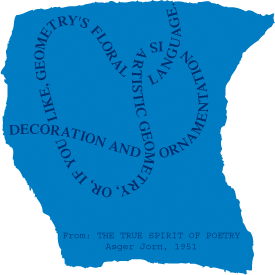
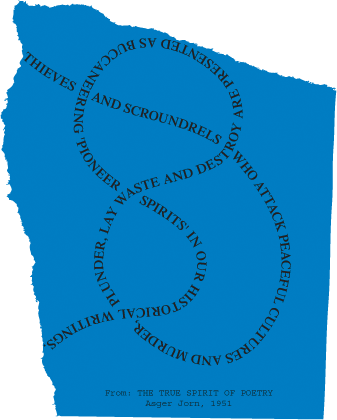
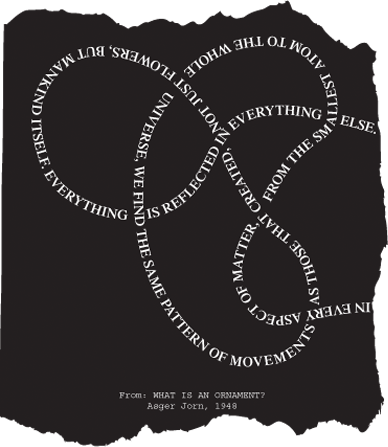
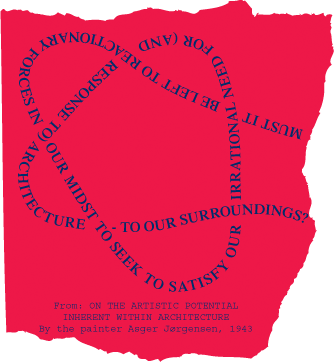
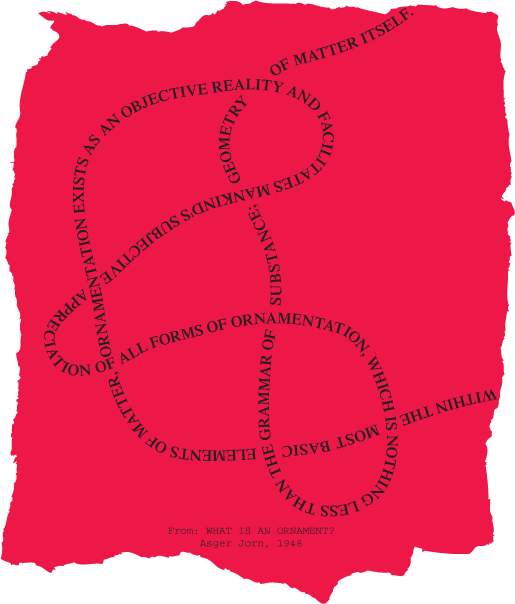
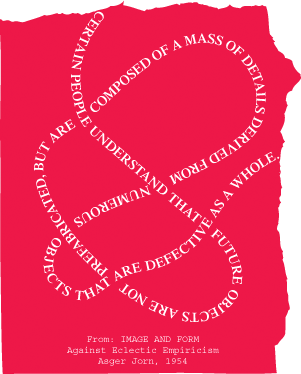
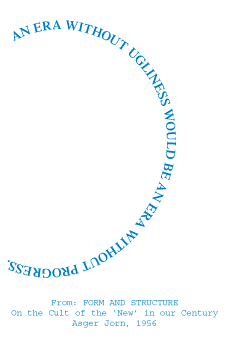
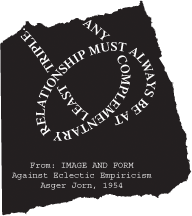
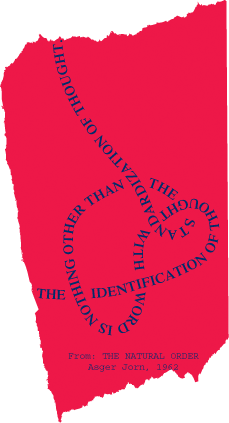
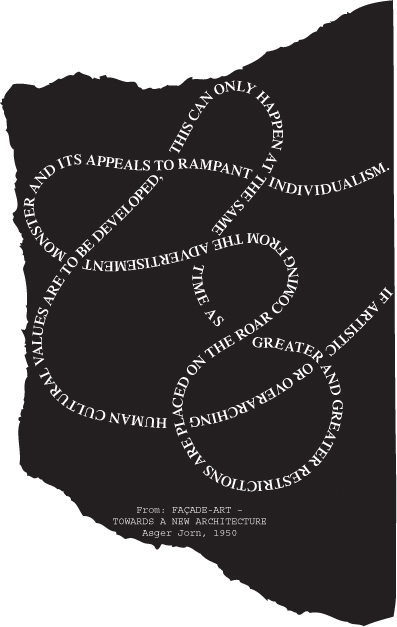
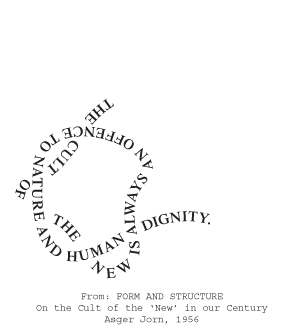
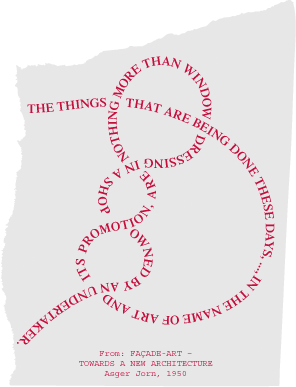
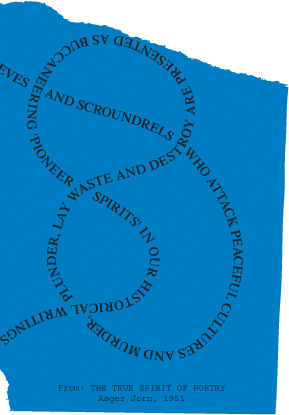
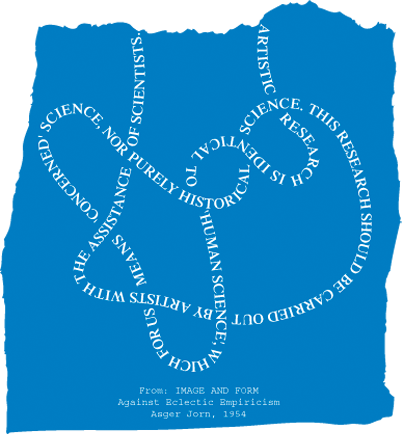
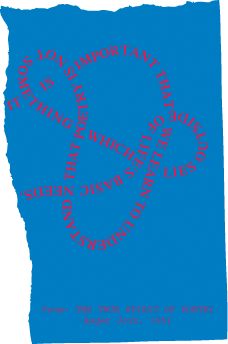
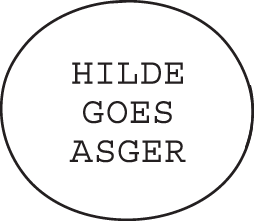
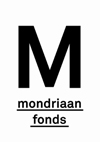
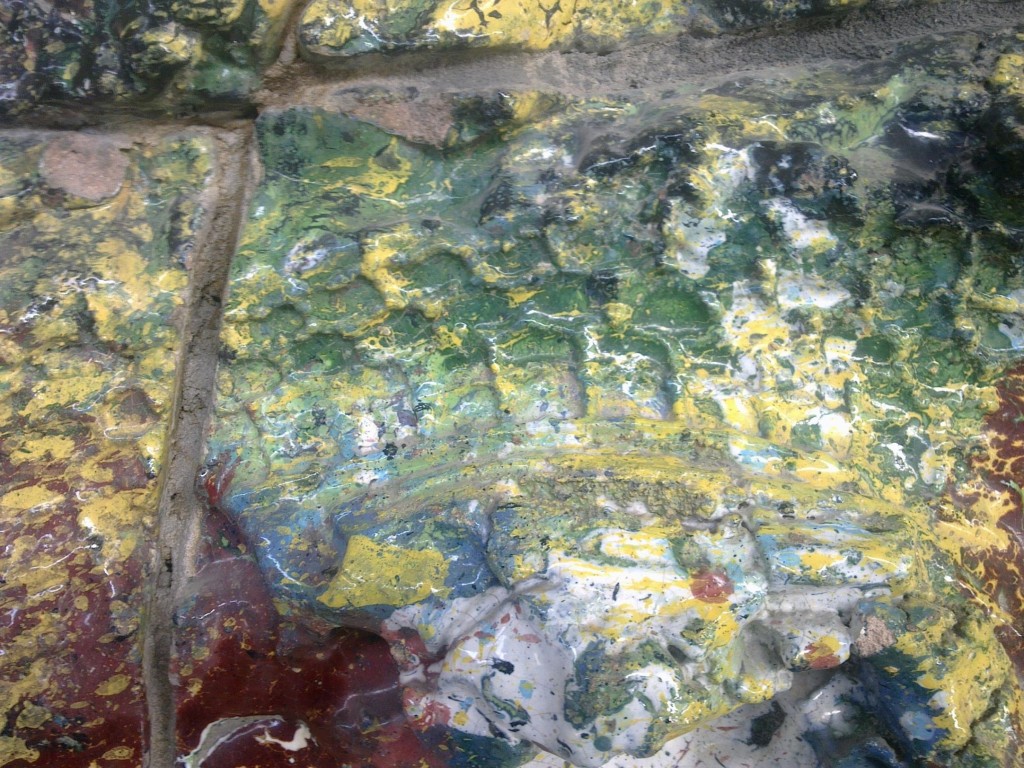
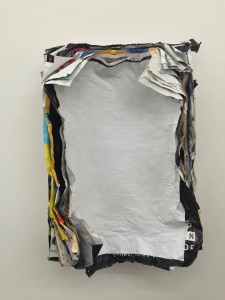

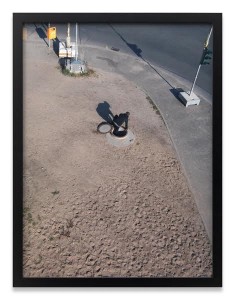
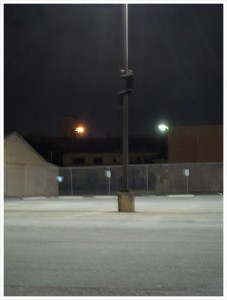
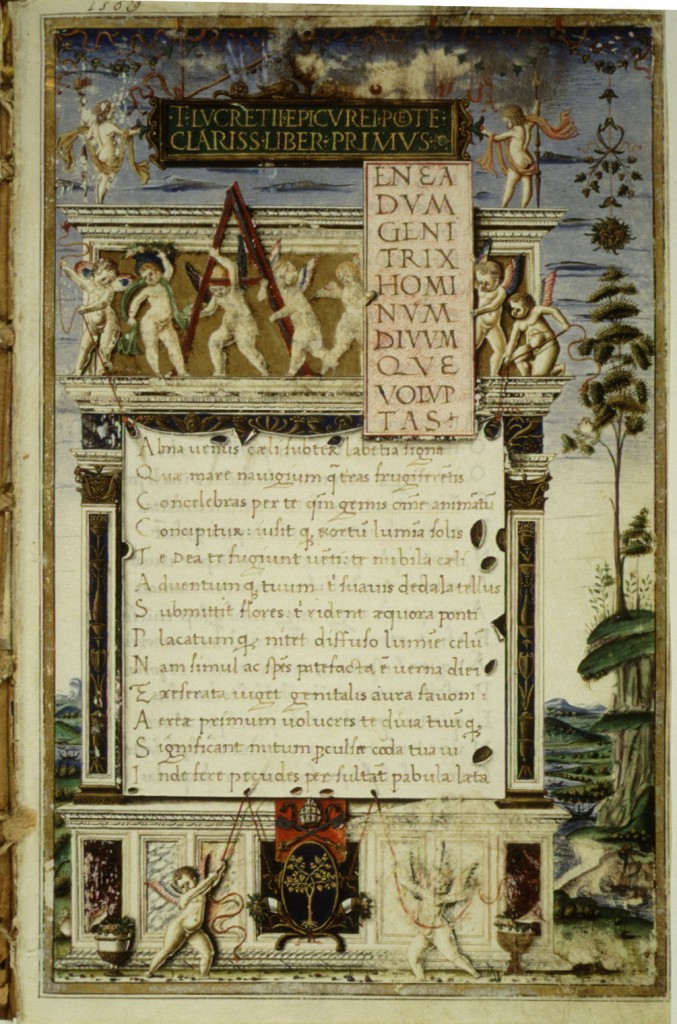

![775t[1]](https://www.hildegoesasger.org/wp-content/uploads/2015/07/775t1.jpg)
